#the protagonist starts off already knowing the thematic truth
Text
Friendly reminder that the suffering and torment Xie Lian experienced actually made him LESS kind, and the lessons he learned as a result of that pain were that human life is meaningless and compassion is worthless and people don't deserve your help or care or love for them. Xie Lian had to backtrack and reject these new lessons in favor of the old ones he had already known in order to return to being kind.
Xie Lian losing everything he loved and knew, being stripped of his power, autonomy, safety, and community, and being ridiculed and humiliated, did not teach him anything worth knowing. He did not learn any valuable or important lessons from it. In fact, he needed to consciously decide that he wasn't going to let it change him and work to go back to the person he was before all that shit happened in order to avoid turning evil.
#TGCF#Xie Lian#Heaven Official's Blessing#i thought we were past this discourse but it's on my dash again#xie lian did not need to endure all that crap to learn any lessons#xie lian does not have a hero's journey!#TGCF is a flat arc#the protagonist starts off already knowing the thematic truth#it's the rest of the world that believes a lie
1K notes
·
View notes
Text
Principles of the Steadfast, Flat-arc Protagonist

Last week I debunked six myths about the steadfast (also known as the flat-arc) character. Now, I would like to share 6 principles of writing a positive steadfast protagonist.
Steadfast/flat-arc characters are characters who don't drastically change their worldviews over the course of the story. In contrast, a change character will do largely a 180 flip in worldview from the beginning of the story to the end of the story.
For example, in Wonder Woman, Diana begins the story with the perspective that we should fight for the world we believe in. At the end of the story, she proves that true by using it to defeat the antagonist (this helps make up the story's theme). But in Frozen, Elsa begins the story with the worldview that one must be closed off to be safe and authentic. Because of the story, she learns that, actually, we must be open to be loved authentically (that might mean we get hurt, but some love is worth the hurt). This enables her to set things right, which proves that perspective true (and helps make up the story's theme).
Both flat-arc characters and change characters have negative versions: a character who remains steadfast to an inaccurate worldview and suffers punishment for it, and a character who changes from a true worldview to an inaccurate one and suffers punishment for it. Negative versions of each type are harder to find, but not nonexistent.
Almost all protagonists are positive change-arc protagonists. This means that almost all writing resources help writers write positive change-arc protagonists. This also means there are very few resources to help writers write steadfast protagonists.
You often can't apply change-arc advice to steadfast characters. It doesn't work.
Luckily, whichever protagonist type you're writing, each story actually has pretty much the same structural pieces--they're just arranged differently. Some are reversed while others receive more emphasis.
Today I'm going to explain how these pieces are different for a positive steadfast protagonist story, in comparison to the common positive change protagonist story.
This is a little like being left-handed in a right-handed world. That's it--the steadfast protagonists are the lefties of the storytelling world.
First, I would like to acknowledge those in the industry who have helped me understand the flat-arc protagonist and therefore influenced this post. If you want to learn more about this protagonist, check out these resources:
K. M. Weiland's Character Arc Series (Katie is amazing and this is honestly the best resource I've found so far on flat-arc characters.)
Character Arcs by Jordan McCollum (This book has a brief section on the flat arc.)
"Character Arcs 102: Flat Arcs" at The Novel Smithy (Lewis succinctly breaks down the flat-arc protagonist's three-act structure.)
Dramatica Theory (I already mentioned last week how Dramatica uses the term "steadfast" instead of "flat arc")
Writing Characters Without Character Arcs by Just Write (Youtube video)
I'll also be doing more posts on this protagonist type in the future.
1. Reversing Orientation: Change <--> Steadfast
Despite being the "lefties," almost every story will feature a key flat-arc character, like I mentioned last week:
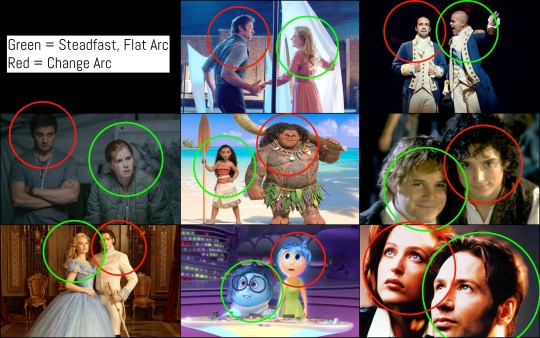
In stories that have a change protagonist, the steadfast character will be the Influence Character. The Influence Character is typically someone the protagonist has an important relationship with, especially through the middle of the story. This is usually a love interest, mentor, or sidekick, but it can be almost anything. Of course, there are variations to the Influence Character, and you can learn more about them in my article on them. The Influence Character also serves as a thematic opponent, to some degree.
Why is the change protagonist most commonly paired with a steadfast character?
Dramatica Theory argues that it's because in order for a story to feel "complete" or "whole"--to properly mimic the human experience--we need to witness each perspective. Otherwise, it feels like something is missing.
It's not impossible to have a change protagonist be paired up with another change character, it's just that when this happens, usually an outsider who is steadfast gets involved and becomes the real Influence Character for both of them. It's also not impossible for the "Influence Character" to be more than one person. A story may have multiple Influence Characters, or even have a group that functions as the Influence Character.
In a story that features a flat-arc protagonist, the types are reversed. The Influence Character becomes a change character:
Moana is steadfast while Maui is change.
In Arrival, Louise Banks is steadfast while Ian is change.
In Cinderella, Ella is steadfast while the prince is change.
In Princess Mononoke, Ashitaka is steadfast while San is change.
In Wonder Woman, Diana is steadfast while Steve is change. (Steve's change isn't as drastic, but if you watch, he moves from disbeleiving the world Diana talks about, to believing in it.)
Usually, this pairing is positive steadfast protagonist and positive change Influence Character. This means that the Influence Character will usually start on the inaccurate worldview--the opposing side of the thematic argument. They will at least voice or tap into it in some way. By the end, they will have an accurate worldview, adopting the steadfast protagonist's perspective.
Generally speaking, anyway, as there are of course exceptions and variations.
So in a sense, when working with a steadfast protagonist, you are reorienting the structure to focus on the steadfast character, instead of the change one.
2. Inaccurate Worldview: Within <--> Without
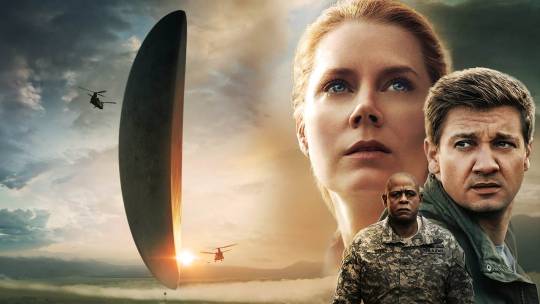
The positive change protagonist has an inaccurate worldview in the beginning--this is sometimes referred to as the "lie" (as K. M. Weiland says it), "misbelief" (as Lisa Cron says it), or "flaw." He will overcome this on his journey and embrace the accurate worldview--the "truth." The truth is also the thematic statement.
The positive steadfast protagonist has the "truth," the accurate worldview, the thematic statement, from the beginning. This means that the inaccurate worldview needs to come from outside them. They need to encounter it in the environment.
You need to have the inaccurate worldview present. Otherwise, there is no opposing argument, no moral conflict.
A theme is essentially an argument about how we live our lives. You can't win an argument if no one is disagreeing. Someone needs to oppose the truth--I like to think of this opposition as the anti-theme. It is essentially the "lie," "misbelief," or "flaw." It is the worldview that is proven wrong by the end of the story.
It's just that with the flat-arc protagonist, that will hit them more from the outside. They will either:
- Enter a society run by the inaccurate worldview
- Have the inaccurate worldview enter their society
- Already live in a society riddled with the inaccurate worldview
Remember, a "society" is simply a collective--it can be as small as a school club or as big as a global government.
I don't know for sure that it always has to be a collective, but even if it's primarily an individual, the inaccurate worldview will still be within the surrounding characters--so in a sense, still part of the environment and society.
In Arrival, Louise is quickly surrounded by people who don't value or understand communication, or how it can avoid confrontation. She does. But she has to put up with that opposition and convince others to share her perspective.
In Princess Mononoke, a demonic boar full of hate and rage enters Ashitaka's peaceful society. After killing it, Ashitaka must journey far away to a land ruled by hate--where he is the only person who stands for peace.
In Wonder Woman, Diana must leave her society behind and enter a world war where humankind doesn't simply fight for a better world, but actively kills the innocent.
Rather than the protagonist transforming within, the positive steadfast protagonist will transform those around them, making the environment a better place as they hold steadfast to the true, accurate, worldview.
3. Internal Journey: Changed vs. Challenged

There is sometimes this idea, this . . . inaccurate worldview 😉 in the writing community that steadfast protagonists can't have rich internal journeys. As someone who loves the internal journey the best out of the plotlines, and who loves many steadfast protagonists the best, I don't find this to be true. Some of the most emotional internal journeys I've experienced, have come from positive steadfast protagonists. And one doesn't have to look far to find examples: The story of Jesus in the New Testament has moved whole nations.
It's fair to say that some steadfast protagonists don't have much of an internal plotline, like classic Superman or 007, but that has more to do with structuring plotlines than it does with character arcs.
For the change protagonist, the internal journey will largely be about transformation--a change. It's a journey to become a better person, and that can be a rich journey indeed.
For the steadfast protagonist, the internal journey will be a test of their beliefs--a challenge. It's a journey about ultimately choosing to hold strong in what you believe in, even if it seems the whole world is against you, (and for a steadfast protagonist journey, that's probably a good idea).
In a strange way, though, these two internal journeys are two sides of the same coin. After all, the change protagonist believes his worldview is the accurate worldview--that's why he has it! He doesn't believe, or at least doesn't clearly see, that he needs to change. The obstacles of the plot will reveal to him he could be wrong, that he needs to fix something about himself. Similarly, the steadfast protagonist believes she's right, and the obstacles of the plot will challenge that by suggesting she could be wrong and needs to bend to the opposing force.
One might argue that the main difference, then, is that the positive change protagonist succeeds at the end by changing, and that the positive steadfast protagonist succeeds at the end by not changing. But I think most of us would agree it'd be more helpful if we differentiated them a little more.
Because the transformation aspect is missing from the steadfast character, it becomes arguably more important to nail the other features of the internal journey. It's not that those features don't exist in the change journey, it's just that without the change itself, they carry more weight and become more centre stage (generally speaking).
One of the aspects that becomes critical, is that the steadfast protagonist needs to pay a high cost. If having an accurate worldview and using it to change the world around them is about as difficult as a stroll in the park, it can become annoying fast. Real life just isn't like that. Even when we are doing good, we still experience hardship, suffering, and opposition. If the steadfast protagonist doesn't have to pay a cost, then they're not really having their beliefs tested.
While a change protagonist's pain may come more from being wrong and having to change--in a sense being "punished" for being wrong--a steadfast protagonist's pain will come from being right and suffering for it, and having to remain true despite that. Essentially they embody the adage, "No good deed goes unpunished."
For example, in Princess Mononoke, in Ashitaka's quest to bring peace to a world at war, Ashitaka must endure a bullet, stabbing, and face death. He's no one's enemy, but he sometimes gets treated as one. He would likely suffer less if he just joined the war efforts and embraced the inaccurate worldview, or if he simply left. Likewise, Jesus holding true to his beliefs in the New Testament, led to him being crucified.
As the obstacles of the plot mount, the steadfast protagonist will be asked to doubt their worldview. Some steadfast protagonists entertain doubt more than others. This may lead to the protagonist wavering in his or her beliefs. Ashitaka entertains doubt only a little, while in Wonder Woman, Diana is brought to her knees by doubt, nearly turning her back on her beliefs. Doubt will usually be strongest at the end of the middle--what some call "The Ordeal," which will lead into the “All is Lost” and "Dark Night of the Soul" moments.
Often, in order for this to work well, the opposing argument needs to appear valid. It needs to look as if the inaccurate worldview could actually be the accurate worldview. It needs to look like the anti-theme could actually be the theme. Like the "lie" could actually be the "truth." This means it becomes perhaps even more important, for you as the writer, to show the legitimate strength of the opposing perspective. If it's obvious the theme is the "truth," then there is no need for the protagonist to experience doubt. There isn't even a need to have a thematic argument. The protagonist may also (or sometimes, instead) doubt his ability or worthiness to live and spread the truth. For more on the power of doubt with flat-arc characters, check out K. M. Weiland's article "Why Doubt is the Key to Flat Character Arcs."
Like costs, stakes become more critical. Stakes are potential consequences. They put pressure on the protagonist and give their choices meaning. If sticking to their worldview means they must suffer steep consequences, their actions carry more weight. It's easy to do what is right when you have nothing to lose. If I found a lost dog, it would be easy for me to look at its tags and return it to its owner. If I found a mean dog trying to bite my hand the evening before my piano recital, wrangled it, saw it belonged to my worst enemy, and still chose to return it--that reveals just how committed I am to saving those lost.
The steadfast protagonist needs to be challenged and tested--one of the best ways to do that is to raise the stakes. Raise them high enough to get them to hesitate, to doubt, to pay a steep cost. In a rich internal journey, we want to push the steadfast protagonist to her limits. What is it going to take to get your protagonist to consider the opposing side? To tempt her to give up her beliefs? In a sense, through the middle, we are really throwing temptations at the protagonist, trying to get her to give in to the opposing argument. Sometimes the most powerful way to do this, is to give the protagonist conflicting wants.
In reality, the audience can't fully see just how steadfast the protagonist is, if she doesn't have to suffer costs, legitimate doubts, and high stakes. It's only in the face of adversity, can we measure true character.
That is the meat of the steadfast protagonist's inner journey.
* I would like to add just one warning, however. In your quest to make your steadfast protagonist struggle, it's important he or she still has some victories along the way. Just as it becomes annoying if the steadfast protagonist never has to struggle, it can also become annoying if the steadfast protagonist never has any success.
4. Ghost/Wound: Inaccurate Belief <--> Accurate Belief
(This is a repeat section from last week. I just thought it would be helpful to have all these elements on the same post.)

A "ghost" is a past, significant, often traumatic event that motivates the character to adopt an inaccurate worldview (the "anti-theme" or the "lie" or the "misbelief"--depending on your preferred terminology). In the industry, this is also sometimes called a "wound." You can learn all about ghosts/wounds in my article, "Giving Your Protagonist a Ghost."
But in a positive steadfast protagonist, this is often flipped. The ghost is often a past, significant, sometimes traumatic event that motivates the character to adopt the accurate worldview (the "theme" or the "truth" if you prefer).
For example, Cinderella's mother, while on her deathbed, tells Cinderella to always be kind. This motivates Cinderella to do just that.
Of course, not every character will have a ghost addressed in the story.
For the positive steadfast protagonist, the ghost may be largely resolved.
But not always. They may not have complete closure and peace. And it's possible they are still traumatized by the event.
Sometimes adhering to what is true can be nearly as haunting as having regrets. It's just that the haunting will come from either the cost of the truth, or, a lack of power--a lack of control--during the ghost. Generally speaking anyway.
In The X-Files, Fox Mulder, in the overall story and theme, is a positive steadfast character. The ongoing theme is an argument of belief vs. disbelief. (The motifs, "I want to believe" and "The truth is out there" speak to that.) However, Mulder has an unresolved, traumatizing ghost: his little sister was abducted by aliens.
This event cements him to the thematic truth of belief and motivates him to investigate anything unnatural. But this happened at the cost of his sister.
Sometimes the trauma comes from not being able to do anything, just as Mulder was powerless to stop the abduction.
Other times it may come from not being able to stop a loved one from choosing the inaccurate worldview--the "lie," "anti-theme," or "misbelief." The steadfast character may be haunted by the outcome of someone else choosing the lie.
5. Want vs. Need <--> I Want the Need
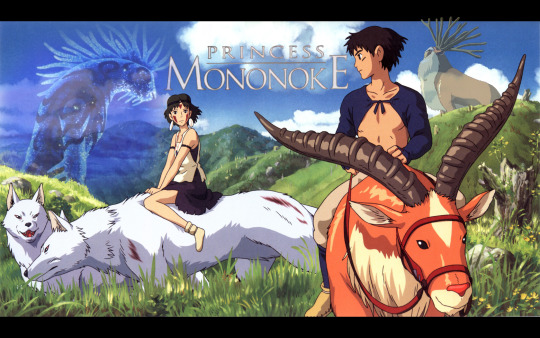
For all other character arcs, what the character wants and what the character needs will be two different things. You can learn about want vs. need in depth here.
In a positive change arc, the protagonist will want something that will manifest in concrete goals, which helps make up the plot of the story. Elsa wants to live in isolation to be herself, so she runs away and creates an ice castle (accidentally freezing the kingdom in the process). The need will be a realization that is thematic--it will be the thematic statement. Elsa needs to learn to be open to love to be authentic--that's what will actually solve her problems.
For the positive steadfast protagonist, the want and the need will be more closely aligned. The protagonist wants what is needed. In a sense, he starts the story with the need. However, the need still has to be applied to the concrete world, which isn't necessarily easy. In a sense, we are taking the need that is within, and trying to apply it to the "real world," which is without. For example, if I know I need to exercise to be healthy, then I probably also want to do that. But that means I still need to put in the work. It also doesn’t mean I know everything about the process--because I may not have full experience with it. I might need to learn a new skill, like how to swim properly.
In Moana, Moana already knows who she is on the inside (thematic statement)--she knows she and her people are meant to sail--but she still has to learn how to sail.
Ashitaka knows the world needs peace, but he doesn't know how to make peace happen within a war. He knows how to have an inner peace, but he doesn't know how to make the external world--the societies around him--peaceful. He's trying to figure it out along the way. He's trying to figure out how to apply a personal experience to the public environment.
The protagonist may still need a greater, more complete understanding of the need, the theme, and how to properly apply it to the real world. We all want to solve world hunger--but how do we actually do that?
On top of that, as the protagonist struggles to meet the need, you may want to tempt him with a conflicting want. In Sam Raimi’s Spider-Man 2, Peter Parker both wants what is needed (to be a self-sacrificing hero) and wants a personal want (to live an ordinary life with Mary Jane Watson). This creates inner turmoil. (And also gives more meat to the internal journey.)
As tests and doubts get heavy, the other want may appear more "right" and enticing. It will almost certainly appear easier.
As tests and doubts get heavy, the flat-arc protagonist may lose sight of the need. In Wonder Woman's "All is Lost" moment, Diana doesn't want to fight for the world she believes in anymore. The world doesn't deserve it. She loses sight of the need, the theme.
In short, the struggle comes from trying to apply the need, being tempting with another want, and/or losing sight of the need.
6. Protagonist Changes <--> Cast Changes

I touched on this earlier, but it's worth giving its own section.
In many positive change protagonist stories, the protagonist will change to the worldview some of the cast members around him have. In Spider-verse, Miles Morales must learn to persevere like the other spider people around him.
In many flat-arc protagonist stories, the cast around the protagonist will change their worldviews to match hers. Moana's journey changes not only Maui's understanding of himself, but Te Fiti's, and everyone's on the island as well.
In some flat-arc stories, this can be critical at the "All is Lost" moment, because if the protagonist is suffering serious doubt, the supporting cast can bolster her by now acting on the accurate worldview, which is essentially what happens in Wonder Woman. As Diana crumbles under doubt, all of her team members enter the fray, prepared to die to make the world a better place. Their selfless sacrifices wake her up, and she recommits to the theme, finding the strength to take on Ares.
Some stories may emphasize these changes more than others, but pretty much always, the Influence Character will at least experience a noticeable change--usually demonstrated near the same place in structure that the change protagonist will change.
But applying the steadfast protagonist to story structure will be for another day (hopefully in the coming weeks). Stay tuned!
#writing tips#writing tips and tricks#writeblr#fanfic#nanowrimo#writing reference#writing advice#protagonist#steadfast protagonist#flat-arc protagonist#moana#arrival#princess mononoke#wonder woman#character#character arcs#writing help
264 notes
·
View notes
Note
Can't speak for anyone else but I for one would love an incoherent rant about the dark age of the law plotline
Alright buckle up kiddos.
So I have a lot of complaints with Dual Destinies as a whole. It’s a poorly paced mess, the final confrontation was deeply underwhelming, it has all these weird “Gotcha” moments where they put in the most bizarre, logic breaking plot twists and then undo them within ten minutes completely for shock value. And yet, despite all of these issues, there is nothing in this world that pisses me off more than the words “The Dark Age of the Law.”
I hate the Dark Age of the Law subplot more than literally any other thing in Ace Attorney. It is a complete failure of a story in literally every possible way. It not only doesn’t work within the context of Dual Destinies, it also completely flies in the face of everything we understand about the original trilogy! It!!!! Sucks!!!!
But no. That was too coherent. I think we should break this down.
First I’m going to start on a macro level. The Dark Age of the Law is the clearest indication to me that the writers of Dual Destinies never played another Ace Attorney game. They treat this Dark Age of the Law thing like this big bad, this shiny new toy, this never before seen wonder, but??? Corruption has been a CENTRAL part of every single AA game since game one!! Since case 2 even!!!
The Dark Age of the Law is this whole idea that people have lost their trust in the court system. And what do they site as the catalyst for this breaking of trust? Phoenix Wright’s disbarment and Simon Blackquill’s arrest.
And okay. Phoenix Wright’s disbarment is a reasonable one. Phoenix was sort of known for being this paragon of truth and justice, this man willing to do what it took to find the truth and protect people in need. His name being smeared through the mud could very well shake up the foundations of trust that the people had in the court system.
But Simon Blackquill? Simon FUCKING Blackquill shook up people’s faith in the court system?? Simon Blackquill is the reason that people are convinced that the entire system is full of lies and deceit? SIMON CONFESSED!! He didn’t even do anything corrupt!! He murdered a woman, sure, but he then immediately lets everyone know “Yes, I super did this murder. No one else.” And they treat it like it’s this big turning point??
LANA SKYE!! You guys remember Lana Skye? The Chief Prosecutor at the time, who was accused of murder, and who still went to prison for doing like a million other crimes after being blackmailed by the chief of police.
SPEAKING OF WHICH the fucking CHIEF OF POLICE was a murderous monster who blackmailed people and also murdered. Did that have no effect on people’s trust in the courts?
Manfred von Karma? Never lost a case in 40 years, literally everyone talked about how he and Miles were KNOWN to be corrupt? Also, you know, murdered a man in cold blood?
Blaise Debeste??? Chairman of the fucking ETHICS BOARD???????? Like!!! That’s some deep fucking corruption right there!!!! And he constantly talks about the mysterious disappearances around him of people who disagreed with him, does that not shake your faith?!
In Turnabout Sisters, as early as case 1-2, Redd White calls up the Chief Prosecutor (who also is not Lana, just to be clear) and demands his complicitness in covering up his own crimes. That’s how central corruption is to the entirety of Ace Attorney.
And you’re going to look me in the fucking EYES and tell me Simon Blackquill, some 21 year old nobody with no power or influence, who theoretically stabbed a woman and made no effort to cover that up, is the reason the courts have lost the faith of the people? You have the NERVE??? the AUDACITY??? the fucking GALL????? to tell me that SIMON is what caused this? The system was never trustworthy, and if it was, what the FUCK did Simon have to do with changing that???
Horrible. Terrible. Disgusting.
BUT
Let’s pretend for a moment that Dual Destinies existed in a vacuum. First Ace Attorney game you’ve ever played. Never touched another one in your life. If you were unfamiliar with the world that Ace Attorney has already spent six games establishing, does the Dark Age of the Law subplot hold up?
No. No it doesn’t.
So as I’ve said a million times before, it was clear that Dual Destinies should not have tried to juggle three protagonists. It just didn’t work. They learned their lesson and booted Athena out of that protagonist title in SoJ, and as much as I hated that decision, it was at least a much stronger overarching story for it.
Now. There were three main throughlines in Dual Destinies. Athena’s story centered on introducing her, of course, but it also was about her struggle to save a friend who needed saving from the law and also himself. It was very AA1 in that way.
Apollo’s story was a little harder to outline, because a lot of it is saved for the last couple of cases, but it’s really about his relationship with Athena. Coming to trust her, his trust in her being shaken, struggling to overcome that, grief, loss, yadda yadda, and I have my criticisms of how it’s handled, but that’s the gist of it.
And Phoenix needed a story. So they made up this stupid fucking bullshit garbage and dumped it in his lap and said “Here you go, best friend! Our dear money maker! This is what you’re working with!” And then they proceeded to use it to beat the shit out of Phoenix until he started spitting out dollar bills.
Okay no sorry I have no idea what the fuck I just said but liSTEN
The Dark Age of the Law storyline was clearly supposed to have some significant thematic relevance to the story, given how hard they were hammering it into us in case three. It was supposed to mean something, and I think it was supposed to mean something to Phoenix in particular. After all, he and Miles won’t stop TALKING ABOUT IT GOD MAKE THEM SHUT UP
The Dark Age of the Law subplot had nothing to do with that final case. Remove it, and nothing changes, because, again, Simon had nothing to do with the corruption in the first place, and the Phantom certainly had nothing to do with corruption. It’s so surface level. “Uh oh, people don’t like the courts. If you can solve this unrelated crime, everything will be fixed.” And then he does (also Athena should’ve been the one to win the case, but that’s a different problem) and nothing ever comes of it, other than “Hooray, you fixed the corruption!” He didn’t??? Miles what the fuck are you talking about????
If they had woven in the corruption throughout the story somehow, maybe it would’ve found some way to be impactful? But it was a floundering, half-thought-out subplot in an already bloated game that failed to give any meaning or help anyone develop as a character. Hell, it kept falling out of relevancy and only popped in to rear its head when the writers remembered it existed and decided to have yet another person remind us that THIS IS IMPORTANT GUYS NO REALLY.
Like! Okay. What if they tied it more to AA4? I mean Phoenix’s disbarment and subsequent return could’ve actually affected the plot. Have people actively mistrust Phoenix or something. Or maybe have it affect anyone in any way. Sure it divides the fucking high schoolers for that mess of a “power of friendship” storyline, but so could a plot about, I don’t know, electing a homecoming queen or something. It affected Athena for one case, but what did that even teach her other than “Trust your gut, sweetie, don’t do lawyer crimes!” Phoenix didn’t have an arc in this game, and he shouldn’t have had to, unless it was coming to grips with the fact that he was never going to get those 7 years of his life back and the smears against his character were always going to linger. But they didn’t do that, they just needed him in there for brand recognition.
I can handle a lot of bullshit in these bullshit lawyer games. That’s part of the appeal. But unlike most of the other bullshit, this particular threat was unsatisfying, meandering, and unnecessary.
#ace attorney#dual destinies#i love dual destinies guys really#but if miles says dark age of the law one more time#also was this coherent at all?#j#spoilers#meta
122 notes
·
View notes
Note
Advice on how to write subplots/weave them into the main story?
ohhh Subplots are fun. And very important for fleshing out your supporting cast, your setting, whatever you need to say that is tough to squeeze into the Main Plot.
This is all stuff I've learned from stuff other writers have said, from writing A Lot, and just trying to be aware of narratives in Everything I consume. It’s not a Universal Constant, you can and should experiment to find what makes things work for you, but this is what I’ve gathered on the topic:
1. I do think it's important to know some of your (potential) subplots from the very start. If you're writing fanfic or something based off another story, this makes it easy. If you're following a side character, the canon main plot becomes a subplot, other subplots fill in the gaps. You'll already know which characters you want to explore in greater depth.
If you're writing something from scratch, it means you have to explore your own secondary characters. How many allies does the protagonist have? What are they in it for? Is something threatening them? Are your characters going to be travelling? If so, what in the setting will they encounter? If you have even a vague idea of the things you want to examine in greater depth, then you can set them aside and either pepper them into your outline when action/tension seems low, or you need to fill a gap. If you're pantsing it'll mean you have a list of ideas in case you ever get stuck.
Pantsing makes it easier and harder to do subplots: it can become very simple to get lost chasing a plot bunny, but it can also be difficult to expand if you aren't aware of extra characters and setting details. This happened to me in November--I had a basic idea and because I was making up characters on the fly, I never fleshed them out and gave them their own motivations. So I never really got to include any subplots--I’m left with something very simple and concise. I’ll have to add in subplots in a rewrite.
2. All your subplots should be strongly connected to the main plot in some way. This could be a direct, physical connection (Ally 1 was displaced by Main Threat and is now looking to achieve X, MacGuffin was stolen by Antagonist or Underling and we must retrieve it for Encounter 2, Ally 2 has a history with Underling and wants revenge/to save them/etc).
Or, it could be thematic. Your story might boil down to one ideal, or a specific dichotomy, or a philosophical 'what if' question. Try to keep your subplots related to that--they can oppose the main theme, or compliment it, or bolster it. Whatever you think would be the most fun to write.
Subplots can also get the Protagonist something that strengthens them for the Final Confrontation. Succeeding at a subplot, or even failing, can win them allies, or tools to succeed later, or help them realize that something they are doing is wrong. It could even help only the reader to see that perhaps the Protagonist is doing something wrong, thus building tension as they wonder how the hero will overcome their flaw/whether they'll be able to succeed.
If you're a planner, make charts, connect pins with little strings, whatever you need to while you’re constructing your outline. If you’re a pantser, make notes as you go to either revisit ideas later, or fit in later as your characters make their own plans. Ask questions of everything and upturn as many stones as possible looking for surprises. Write hypothetical scenes/chapters and see if they offer you any ideas.
3. Don't add everything at once. Start off with the main plot, or an offshoot of that--just a bit of information. Add a little at a time, one or two new ideas per chapter, gradually expanding the world of your story. Subplots should never have higher stakes than the main plot, but they can add a sense of urgency if they have steadily escalating intensity. If they reveal things about the Main Plot, be it a truth about a character, or about the magic of the world, or some horrible secret, it'll make them feel Integral to the story. If you tried to extricate them, you'd tear up half the story. That's good. See if you can attach a Main Plot Point to a subplot whenever possible.
4. Sometimes it'll feel like it's getting cluttered. Maybe you have too many main players, too much going on. Look at examples of stories that have a lot going on. I found that in particular, Good Omens (Neil Gaiman, Terry Pratchett) and The Dark Lord of Derkholm (Diana Wynne Jones), dealt with that really well. These writers break things up, compartmentalizing all the subplots. Separate events and characters and points of view to cover more ground and flick back and forth between them. Do so in relation to how much is happening.
5. In the end, you have to bring everything together, and it's at that point that you need to strip back all the subplots.
Build the tension. Make it clear how everything has been building up towards the Final Confrontation. Show how much is at stake, not just for your Protagonist, but Ally 1 and Ally 2 and all the little encounters you had on the road. I’m not saying write out a summary of the entire story thus far, but show the growth, show what your characters are feeling about what’s to come, and what would happen if they failed. Show the themes that you’ve been building up.
Then, let them fall back to the reader's subconscious. It's time for the Main Plot. All that your characters have learned and experienced in the subplots, all the themes contrasting and supporting the main theme, will come to fruition now. It should result in catharsis, and drama, and a release of all the tension that you’ve been carefully piling on, and feel satisfying to the reader. You don’t have to conclude every subplot, but you should acknowledge the big ones at the very least.
TL:DR
The Main Plot: The basic pitch/premise/thread of your story, 'Protagonist faces X with the result of Y'
The Subplots: Exploring supporting character motives, the Setting, the Villains, etc, all with the purpose of propelling the reader towards the conclusion of the Main Plot.
Subplots make us care about the world and the supporting cast, they increase tension, they move us towards the Conclusion. They can feel to the characters like distractions/diversions from their goal, but in the background, they should always be used by the writer as a tool for furthering/strengthening the plot, directly or not.
#writing#writing asks#plot#subplot#keep in mind i'm essentially self-taught#but plot is a special interest of mine#i hope this is helpful to you!#also longer pieces will naturally have room for more subplots#test and learn the limits of your story
30 notes
·
View notes
Note
Have you been asked yet to rank Trust eps? Cos I'm asking! But your the criteria for ranking I leave to you to decide.
Ahahahaha I’ll have you know I put way too much thought into this. :-D
Ok so first of all, there is no such thing as a bad episode of Trust. The whole thing is really tightly written, every character and plot thread has a purpose, and even the episodes that I haven’t watched over and over again are important to the overall story. And a lot of the impact of the show comes from things that are cumulative over multiple episodes.
That being said, I do have favorites. Since the definitive ranking of Primo’s outfits has already been taken care of, here is my ranking from least to most favorite based on some nebulous criteria of artistic/narrative effectiveness and emotional impact, my judgement of which is obviously highly subjective and also correct.
Under the cut because this got ummm unbelievably, ridiculously long.
10. The House of Getty (episode 1)
Sorry Danny Boyle and Simon Beaufoy, the pilot is my least favorite episode. Still think it was the wrong choice to open with a flashy (and, I can tell, expensive) sequence showcasing the death of a character we literally never see again. And, look, I’m an impatient viewer. If I don’t get someone to root for/emotionally identify with/otherwise catch my interest early on in a narrative, I’ll tune out. And Old Paul is not only unlikeable--far from a mortal sin in dramatic storytelling--he’s boring. I don’t care about any of his rich people problems, and I’m not the kind of viewer who can be kept engaged just by hating someone and watching them be terrible.
Some of the secondary characters in the Getty household do have interesting plotlines, but we don’t get to learn very much about them in the first episode. And I do think things get interesting once Little Paul shows up (although I maintain that the whole episode is more interesting if we understand what the stakes are for Paul getting the money), but if I had started watching this show with no context I wouldn’t have made it past Old Paul’s pre-coital erotica listening routine.
If this had been anything other than the first episode I might not have ranked it last, but extra penalty points for leading with your least interesting characters.
9. Lone Star (episode 2)
This episode is, I think, saddled by the fact that it has to do a lot of heavy lifting in terms of exposition and setup. It mostly works because Chace is an entertaining narrator, and once we get to Italy with Gail I think things zip along at a pretty good pace. Opens with an attempted rape to show how Bad the Bad Guys are, which is...not my favorite trope.
Once again, I think a lot of the information in this episode would have worked better if episode 3 had been episode 1. (We’d already know who Berto was when Chace meets him; we’d already know about the box of guns in the apartment; we’d know when certain characters are lying.) This whole show runs on the suspense of the audience being the only party who knows what’s going on with all the characters at once; I think trading mystery for suspense here was the wrong move. I also can’t help thinking there was pressure to front-load the well-known American actors in the beginning of the show at the expense of the strongest narrative choices.
Imo the best thing about this episode is the sort of...multiple competing images of Paul that emerge. His mom sees him as an innocent victim who couldn’t possibly have planned any of this. Chace sees him as a spoiled rich kid trying to swindle his granddad. Neither one of them has the complete truth.
Next we get into some episodes that are certainly not bad, but their greatness is more on the level of some bangin’ individual scenes than a whole package.
8. John, Chapter 11 (episode 6)
Again, this isn’t a bad episode. The main reason I put it near the end of the list is that the first time through I got sort of impatient during the first half. We, the audience, by virtue of our extra-textual knowledge, know that Paul can’t be dead, and we spend about half the episode before we know what really happened to him, which felt a bit too long to me.
This episode does have some fantastic individual scenes including: Leo talking Primo down in the farmhouse, Leo and Paul’s conversation about Angelo’s death, Gail being an absolute badass, and the meeting between Salvatore and Old Paul. A lot of these scenes are essential on a thematic level, but I don’t think the episode as a whole is the most streamlined.
7. Consequences (episode 10)
I debated for a while where to put this episode because the overall feeling of 57 Chekov’s guns going off in the space of one episode is SO satisfying, and the resolutions of some of the individual plotlines are delicious. Ultimately I would have liked more space for Paul and Gail and less Old Paul being grumpy about his substitute child museum’s mediocrity (although the scene with the bad reviews is hilarious). Once again I feel like the show creators felt they had to pull the focus back to Old Paul to wrap things up and I just. don’t care.
That being said. The resolution of Primo’s storyline? SO SATISFYING. And tbh I don’t dislike the scenes that exist with Paul and Gail; even the happy scenes have this poignant tone to them. I think they were trying to deal with the fact that his irl story is just...incredibly fucking tragic, and you can see a bit of the strain showing.
6. Kodachrome (episode 7)
I know episode 7 is not one of your personal favorites, but it’s the one where I think jumping between multiple plotlines/sets of characters is used to the most satisfying dramatic effect. It has this sense of dramatic irony that feels like some Shakespearean family tragedy. The whole episode, we are hoping that Paul Jr. will finally do the thing we want him to do, which is stand up to his father. And he does it--but at the absolute worst, most selfish and destructive moment possible.
Paul Jr. may be the literal worst, but I do have compassion for him in the flashbacks, mostly because it seems painfully apparent that no matter what he does, he will never be able to please his father. But he doesn’t seem to realize this, and he keeps trying, even as it’s destroying him and his relationship with his family. Credit to Michael Esper for his performance for making me feel a smidgen of compassion for this bastard.
I think the other thing this episode shows is how both of Paul’s parents keep putting him, a child, into roles and circumstances that he shouldn’t really be in. He’s wandering around through what seem like very much adult environments with his dad and Talitha in Morocco. In the Trust version of events he’s there when Talitha ODs and is the one trying to revive her while his dad is having a breakdown in the corner. Gail seems like the more responsible parent but there’s something about her bringing Paul as her “date” on a night out, and the understanding that this is a thing that happens regularly...to me the disturbing part is not so much bringing a young kid to a party with adults but the unspoken expectation that Little Paul will fill the void of companionship that his father has left empty. (Gettys expecting Little Paul to step in to cover for the failings of his father is a repeated theme, and it even plays into the ear thing. His family has failed to pay the ransom, so this is now a problem he has to solve himself.) Combine this all with Leonardo going, um, excuse me but what the actual fuck is wrong with your family? and I think it makes a very effective episode. And the last couple minutes had me yelling NOOOOOOOO GODDAMMIT because you can see what’s going to happen and you’re just watching it unfolding like a car wreck. Also has one of my hands-down favorite scenes, of Paul and Primo in the car waiting for the ransom.
5. White Car in a Snowstorm (episode 9)
The ~ D R A M A !!! ~ This episode is an opera. I mean this whole show is dramatique but episode 9 really leans into the vivid imagery--that snowy highway in the mountains above the sea, the all-white ransom exchange, Paul clinging to the pole at the shuttered Getty gas station, some Very Serious Mobsters throwing the ransom money around like idiots in a moment where you’re encouraged to be happy along with them.
This is also one of my favorite episodes for Primo and for Primo and Paul’s weird sometimes-alliance. Primo walking away from Salvatore to go tell Paul “they always pay in the end”? Primo and Paul teaming up to argue with Salvatore about why Paul shouldn’t die? Primo being all threateny to the doctor treating Paul because somewhere deep down he is worried (that’s my take and you’ll never convince me otherwise)? Primo dressing up to fake-scab on a postal strike in order to find a misplaced severed ear? All gold.
Fun fact: the letter Gail writes to President Nixon did happen in real life, but as far as I can tell the phone call did not. The real details of who convinced Old Paul to finally pay (some) of the ransom are considerably less cinematic. They’re the same amount of sexist though!
Ok now we are getting to the top tier...
4. That’s All Folks! (episode 4)
This is definitely the episode that took me from “ok this is fun” to “oh holy shit I’m invested now.” It’s the episode where we get introduced to most of the Calabrian characters and their world. It’s also the episode where we start to realize that Primo is not just a fun antagonist but is really a parallel protagonist to Little Paul, with his own set of relationships and motivations that we start to see from his POV. (I’d argue that, with the exception of his very first scene, we’ve mostly seen Primo through other characters’ gaze up until episode 4, and this is the point where we start watching him as like, the character whose pursuit of a goal we’re following over the course of the scene.)
This episode ranks high for capturing so much of the weird mix of tones that makes Trust work. It can be very funny. (I never fail to fuckin lose it when Fifty is on the phone with Gail the first time and when he’s talking to the thoroughly unimpressed newspaper switchboard operator.) It has this weird unexpected intimacy between characters you wouldn’t think would connect with each other. (Primo and Paul, Paul and Angelo; in retrospect the arc of the relationship between Primo and Leo gets started in that scene in Salvatore’s kitchen.) And it has one of the show’s absolute best record-scratch tone shifts when Primo gets the ransom offer. I remember saying “oh FUCK” out loud the first time I watched the end of that episode, when Primo comes back to the house, visibly drunk and clearly furious. We’ve seen him be violent plenty before now in the show, but always in a controlled, calculated way. This is the first time we see his potential for out-of-control rage-fueled violence and he’s terrifying!
3. La Dolce Vita (episode 3)
I stand by my claim that this episode (with a few minor continuity adjustments) should have been the pilot. Can you imagine a title card that’s like “Rome 1973” and then away we go with Paul snorting coke and taking racy photos and jumping on cops and fucking his girlfriend in what is definitely not proper museum etiquette, and then the smash cut to Primo intimidating and robbing and murdering people? And that’s the opening of the whole show? And you’re like how are these characters connected and then they meet each other and it’s the fucking sunflower field scene??
Anyway aside from the fact that I think knowing the information in this episode would have made episodes 1 and 2 more interesting...it’s just a great fucking episode. It’s kinetic and propulsive and funny and tense and violent and features Primo’s sniper skills and his ass in those cornflower blue trousers. I rest my case.
2. Silenzio (episode 5)
I’ll be honest, I went back and forth on the top two a bunch. Silenzio is definitely my personal favorite episode, and I’d argue that it’s the best written, in terms of what it accomplishes narratively, which is to keep you emotionally invested in both Paul and Angelo trying to escape with their lives, and Primo and Leonardo hunting them down. That’s so fucking hard!! And yes some of it is great acting but it starts from the foundation of the writing. It’s just such a perfect little self-contained horror movie, and it has this profound sense of fatalism to it, because you know from the beginning (if only by virtue of only being halfway through the series) that Paul is not going to escape, and you sort of know that there is only one way this will end for Angelo. And yet they escape by the skin of their teeth so! many! times!
It’s also the episode where you see how much power the ‘Ndrangheta has over people’s lives in this community: Salvatore is like God, calling his servants to him with the church bells. Combine that with the visuals of two characters running for their lives mostly on foot through this unforgiving landscape, and you really get the sense of this environment as a harsh place where most people have a very constrained set of choices, and the claustrophobia of that. You get the sense in this episode that everyone is trapped in these expectations of violence and duty and honor. Angelo did what anyone with compassion would do, and saved Paul from what seemed like certain death, and he’s doomed for it. At the same time Primo is doing exactly what anyone would expect him to do in response to a subordinate who disobeyed him. In some ways the end of the episode feels inevitable, unsurprising, and yet they do SUCH a good job of winding up the tension until the literal last seconds of the episode, and then releasing it with a big dramatic bang. It’s so good!!
1. In the Name of the Father (episode 8)
Ok I’ll be honest the ONLY reason In the Name of the Father edged out Silenzio for the top spot is that it is really clear they pulled out all the stops in terms of making this episode feel extra heightened in a show where everything is already heightened. Like, the cinematography is different? They still use handheld a lot but I swear there are more still shots and more extreme, editorial camera angles like that shot of Francesco looking upward in church where the camera is looking down from above him. I can’t tell if they actually tweaked the color grading or if the bright white and blood red just stand out against the Calabrian color palette which is mostly earth tones, browns and greens and blues.
There are just. So many layers to this episode. The imagery! The literal sacrificial lamb at the beginning, Francesco being guided by Leonardo through an act of violence against an animal, something that I’m sure they don’t even see as violence but just part of farm life, part of survival and in this case part of a celebration, but something that fathers teach their sons how to do as part of becoming a man in this world. Paul as the metaphorical sacrificial lamb later, drawing parallels to Jesus (the lamb of God), Isaac (a father sacrificing his son), any number of martyred saints, pick your Catholic imagery. The blood of the lamb on the tree stump and Paul’s blood on the stone. The communion wafer (the body and blood of Christ) and Francesco at the end with Paul’s blood and a literal piece of his body held in his hands the same way.
And then there is like, the suspense of watching everyone marking time through the steps of this community ritual that’s supposed to be a joyful, communal celebration, while we know that there is a secret ticking away under the surface. The slow unfolding of the lie told to one person spreading to everyone in the village, and then the knowledge that Salvatore knows spreading to all the people who’ll be in trouble for that. The relationship arcs between the main Calabrian characters...not resolving, but sliding into place for the final act. Primo finally being done with Salvatore. Primo and Leo’s alliance being cemented and Leo physically stepping between Primo and Salvatore, to protect Primo. (No one ever protects Primo!! Still not over it!!!!) The confirmation celebration as a mirror of the Getty party in episode 1, the parallels drawn between the 3 Pauls and Salvatore-Primo-Francesco and how Primo reacts to being passed over as heir vs. how Paul Jr. reacts. Little Paul having two whole minutes of screen time and managing to break your heart with them. Regina! Just...Regina’s whole everything. The music going all-instrumental for an episode and having this haunting, dreamlike but still tense quality to it. And the fact that we never cut away from Calabria to another plotline gives the whole episode this hypnotic, all-encompassing quality. It’s just. SO GOOD!!!!
#fadagaski#asks answered#trust fx#long post#so so long omg#i can't believe how long i spent writing this but HERE IT IS#trust alternate watch order
70 notes
·
View notes
Text
The History & Evolution of Home Invasion Horror
Here’s my prediction: In the next couple of years, we’re going to be seeing a sudden surge of home invasion movies hit the market. For many of us, 2020 has been a year of extreme stress compounded by social isolation; venturing outside means being exposed to a deadly plague, after all.
And while many people have already predicted that we’ll see an influx of pandemic and virus horrors (see my post on those: https://ko-fi.com/post/Pandemic-and-Pandemonium-Sickness-in-Horror-T6T21I201), I actually think a lot of us are going to be processing a different type of fear -- anxiety about what happens when your home, which is supposed to be a literal safe space, gets invaded. Because if you’re not safe in your own house...you’re not safe anywhere.

Home invasion movies have been around a long time -- arguably as long as film, with 1909′s The Lonely Villa setting down the formula -- and they share many of the same roots as slasher films in the 1970s. But somewhere along the way, they separated off and became their own distinct subgenre with specific tropes, and it’s that separation and the stories that followed it that I want to focus on.
The Origins of the Home Invasion Movie
In order to really qualify as a home invasion movie, a film has to meet a few requirements:
The action must be contained entirely (or almost entirely) to a single location, usually a private residence (ie, the home)
The perpetrator(s) must be humans, not supernatural entities (no ghosts, zombies, or vampires -- that’s a different set of tropes!)
In most cases, the horror builds during a long siege between the invader and the home-dweller, including scenes of torture, capture, escape, traps, and so forth.
To an extent, home invasion movies are truth in television. Although home invasions are relatively rare, and most break-ins occur when a family is away (the usual goal being to steal things, not torture and kill people), criminals do sometimes break into people’s homes, and homeowners are sometimes killed by them.
In the 1960s and 70s, this certainly would have been at the forefront of people’s minds. Truman Capote’s In Cold Blood detailed one such crime in lavish detail, and the account was soon turned into a film. Serial killers like the Boston Strangler, BTK Killer and the “Vampire of Sacramento” Richard Chase also made headlines for their murders, which often occurred inside the victim’s home. (Chase, famously, considered unlocked doors to be an invitation, which is one great reason to lock your doors).
By the 1960s and 70s, too, people were more and more often beginning to live in cities and larger neighborhoods where they did not know their neighbors. Anxieties about being surrounded by strangers (and, let’s face it, racial anxieties rooted in newly-mixed, de-segregated neighborhoods) undoubtedly fueled fears about home invasion.
Early Roots of the Home Invasion Genre
Home invasion plays a part in several crime thrillers and horror films in the 1950s and 60s, including Alfred Hitchcock’s Dial M for Murder in 1954, but it’s more of a plot point than a genre. In these films, home invasion is a means to an end rather than a goal unto itself.
We see some early hints of the home invasion formula show up in Wes Craven’s Last House on the Left in 1972. The film depicts a group of murderous thugs who, after torturing and killing two girls, seek refuge in the victim’s home and plot the deaths of the rest of the family. In 1974, the formula is refined with Bob Clark’s Black Christmas, which shows the one-by-one murder of members of a sorority house and chilling phone calls that come from inside the home.
Even closer still is I Spit on Your Grave, directed by Meir Zarchi in 1978. Although it’s generally (and rightly) classified as a rape-revenge film, the first half of the movie -- where an author goes to a remote cabin and is targeted and brutally assaulted by a group of men -- hits all the same story beats as the modern home invasion story: isolation, mundane evil, acts of random violence, and protracted torture.
Slumber Party Massacre, directed by Amy Holden Jones in 1982, also hits on both home invasion and slasher tropes. Although it is primarily a straightforward slasher featuring an escaped killer systematically killing teenagers (with a decidedly phallic weapon), the film also shows its victims teaming up and fighting back -- weaponizing their home against the killer. This becomes an important part of the genre in later years!
In 1997, Funny Games, directed by Michael Haneke, provides a brutal but self-aware look at the genre. Created primarily as a condemnation of violent media, the film nevertheless succeeds as an unironic addition to the home invasion canon -- from its vulnerable, suffering family to the excruciating tension of its plot to the nihilistic, motive-free criminality of its villains, it may actually be the purest example of the home invasion movie.
Home Invasions Gone Wrong
Where things start to get interesting for the home invasion genre is 1991′s The People Under the Stairs, another Wes Craven film. Here the script is flipped: The hero is the would-be robber, breaking and entering into the home of some greedy rich landlords. But this plan swiftly goes sideways when the homeowners turn out to be even worse people than they’d first let on.
This is, as far as I can tell, the origin of the home-invasion-gone-wrong subgenre, which has gained immense popularity recently -- due, perhaps, to a growing awareness of systemic issues, a differing view of poverty, and a viewership sympathetic to the plight of down-on-their-luck criminals discovering that rich homeowners are, indeed, very bad people.
Home Invasion Film Explosion of the 2000s
The home invasion genre really hit the ground running in the 2000s, due perhaps to post-911 anxieties about being attacked on our home turf (and increasing economic uneasiness in a recession-afflicted economy and a growing awareness of the Occupy movement and wealth inequality). We see a whole slew of these films crop up, each bringing a slightly different twist to the formula.
* It’s also worth noting that the 2000s saw remakes of many well-known films in the genre, including Funny Games and Last House on the Left.
In 2008, Bryan Bertino directed The Strangers, a straightforward home invasion involving one traumatized couple and three masked villains. By this point, we’re wholly removed from the early crime movie roots; these are not people breaking in for financial gain. Like the killers in Funny Games, the masked strangers lack motive and even identity; they are simply a force of evil, chaotic and senseless.
The themes of “violence as a senseless, awful thing” are driven further home by Martyrs, another 2008 release, this one from French director Pascal Laugier. A revenge story turned into a home-invasion-gone-wrong, the film is noteworthy for its brutality and blunt nihilism.
2009′s The Collector, directed by Marcus Dunstan, is another home-invasion-gone-wrong movie. Like Martyrs, it dovetails with the torture porn genre (another popular staple of the 2000s), but it has a lot more fun with it. The film follows a down-on-his-luck thief who breaks into a house only to encounter another home invader set on murdering the family that lives there. The cat-and-mouse games between the two -- which involve numerous traps and convoluted schemes -- are fun to watch (if you like blood and guts).
In a similar vein, we see You’re Next in 2013, which starts off as a standard home invasion movie but takes a sharp twist when it’s revealed that one of the victims isn’t nearly as helpless as she appears. Director Adam Wingard helps to redefine the concept of “final girl” in this move in a way that has carried forward right into the next decade with no sign of stopping.
2013 of course also introduced us to The Purge, a horror franchise created by James DeMonaco. If there was ever any doubt as to the economic anxieties at the root of the genre, they should be alleviated now -- The Purge is such a well-known franchise at this point that the term has entered our pop culture lexicon as a shorthand for revolution.
Don’t Breathe, directed be Fede Alvarez in 2016, is one of the creepiest modern entries into the “failed home invasion” category, and one that (ha ha) breathed some new life into the genre. Much like The People Under the Stairs, it tells the story of some down-on-their-luck criminals getting in over their heads when they target the wrong man. However, there is not the same overt criticism of wealth inequality in this film; it’s a movie more interested in examining and inverting genre tropes than treading new thematic ground. The same is true of Hush that same year. Directed by Mike Flanagan, the film is most noteworthy for its deaf protagonist.
But lest you start to think the home invasion genre had lost its thematic relevance, 2019 arrived with two hard-hitting, thoughtful films that dip their toes in these tropes: Jordan Peele’s Us and Bong Joon-ho’s Parasite, which both tackle themes of privilege in light of home invasion (albeit a nontraditional structure in Parasite -- its inclusion here is admittedly a bit of a stretch, but I think it falls so closely in the tradition of The People Under the Stairs that it deserves a spot on this list).
What Does the Future Hold?
I’m no oracle, so I can’t say for certain where the future of the home invasion genre might lead. But I do think we’re going to start seeing more of them in the next few years as a bunch of creative folks start working through our collective trauma.
Income inequality, racial inequality, political unrest and systemic issues are all at the forefront of our minds (not to mention a deadly virus), and those themes are ripe for the picking in horror.
I know that Paul Tremblay’s novel The Cabin at the End of the World has been optioned for film, so we might be seeing that soon -- and if so, it might just usher in a fresh wave of apocalypse-flavored home invasion stories.
Like my content? You can support more of it by dropping me some money in my tip jar: https://www.ko-fi.com/post/Home-Invasion-Stories-A-History-R6R72RV7Y
14 notes
·
View notes
Text
Rey as a Palpatine and Why it’s Grown on Me
Hello my lovelies!
I think it’s been quite a while since I posted any kind of essay on here. Between work and other things I honestly haven’t had much time for it. However in recent days I’ve felt very motivated to work on a very particular kind of essay; a subject that I’ve been stewing over since December of last year.
Obviously from the title you already know what I’m going to be talking about. I’m not going to deny that this is a rather heated subject for some Star Wars fans, particularly those who disliked this plot choice and The Rise of Skywalker in general. As per usual in my essays, my goal is not to change anyone’s mind or argue over who’s opinion is “more right”. Plain and simple, this is just going to be me talking about MY thoughts and MY observations about Rey’s journey and lineage in The Rise of Skywalker. I hope this doesn’t need to be said but if you read something in this essay that you disagree with, I politely ask that you keep it to yourself and move on. At the end of the day, we are just talking about a movie, and this is all just for fun.
Now, with that being said, let’s get started! This essay is definitely going to be a bit more structured than my usual efforts and I hope this will result in a much more straightforward and clear-cut essay. Enjoy!
1. My Initial Reaction
While I don’t want this to be a major part of the essay, I do think it makes sense to start this off with a little story about the time I first saw TROS in the theatre. I can remember it pretty well. My whole body was tense, my eyes glued to the screen for what I knew was about to be some kind of major reveal in the story (even if it felt very late in the film for such a scene). Then came those shocking and irreversible words from Kylo Ren: “You’re his Granddaughter. You are a Palpatine.”
Wait…what?
My mind recoiled at this statement. My heart sank into my stomach with complete rejection. This can’t be right. He must be lying. I don’t like it. I don’t like it one bit. A man behind me just snorted with laughter and I can totally see why. Rey being related to Palpatine sounds more like a crazy Youtube fan theory than something that could actually be canon in the Star Wars universe. We had always thought she might be related to Luke or even Obi-Wan, but…Emperor Palpatine? Darth Sidious? No, just no.
So yeah, suffice to say that my first reaction towards this plot twist was not very positive. I admit that even once the movie was over, I still didn’t like this reveal. I don’t even think I began to warm up to it until my 3rd or 4th viewing of TROS. I had become so used to the idea that Rey had no special lineage and she was just a very force-sensitive girl from nowhere that it was extremely hard to let go of that. And honestly, if JJ and everyone else involved had chosen to keep it that way, I would have been perfectly content. So why…you might ask, has Rey’s true lineage grown on me in the last several months?
Now, don’t get me wrong…there’s still a part of me that thinks it was a very odd choice to introduce a reveal like this considering what happened in the previous installment. However…this fact has already been discussed to death and this essay is intended to be more of a story exploration rather than a critical film review. So let’s talk more about Rey being Palpatine’s Granddaughter and how I have actually grown to love the idea.
2. Rey’s Journey
Throughout the trilogy, Rey has had to overcome quite a few challenges in her path to becoming a Jedi. Her journey has been one of mostly self-discovery and personal growth. In The Force Awakens, Rey discovers that she is strong in the force and can do things she never imagined. In The Last Jedi, Rey’s strength in the force grows stronger and she learns to accept that her parents were nobodies and that some things do not turn out the way we expect.
And so, thematically, it would almost seem like Rey has reached the end of her character arc. This is Rey at her most powerful. There’s nothing left to learn, and there are no more secrets to be revealed…right? Well, we know that this is not the case. Even from the first scene with Rey we know that something is wrong. She knows that something is wrong. There is a darkness inside of her; she fears for her destiny and who she is meant to become. It’s not until later that we understand why these feelings have come to the surface.
Up until TROS, we didn’t truly know who Rey was or where she came from. However, by this point in the story anyone should be able to describe her as a character. Kind. Brave. Resourceful. Curious. Compassionate. Strong. Rey has proven time and time again that she is an incredibly kind and capable individual who wants to do the right thing. Although both TLJ and TROS strongly hint towards Rey possibly turning to the dark side, we know that our protagonist never actually would because we know who Rey is.
And this a huge reason as to why the Rey Palpatine reveal works so well for me. There is an incredible juxtaposition with Rey being the most heroic, kind-hearted person imaginable, and yet she is related to the most evil man in the galaxy. There is something deeply profound about the last living Jedi having Sith blood in her veins. Part of the reason why this reveal is so shocking is because the two characters are complete polar opposites in terms of good and evil. Rey is absolutely nothing like Palpatine and so the familial connection seems impossible. It doesn’t just seem like an unlikely truth, it feels entirely incorrect. And yet, that is also what makes it (again, in my opinion) so interesting and bold.
3. Meaning and Impact
Apart from giving Rey one last emotional challenge in the final installment, I think this choice was made for other reasons as well (3 to be precise).
1. It made Rey even more similar to Kylo as he too is grappling with the dark influence from his Grandfather
2. This decision subverts a long-existing trope in fantasy stories
3. Used to further tie the 9 films together as a story about the Skywalker and Palpatine bloodlines
Since The Force Awakens, it was made very clear early on that Rey and Kylo were connected in some way; their destinies were intertwined. Although this was further explored in TLJ, we would not truly understand just how similar their journeys would become until the final installment. The dynamic between Rey and Kylo is infinitely interesting because at first glance they seem like completely opposite people, when in reality they share a very similar struggle, especially in The Rise of Skywalker.
Both Rey and Kylo experience the overwhelming darkness of their respective families. Kylo even says it quite bluntly before the lightsaber duel on the ruined Death Star: “The dark side is in our nature, surrender to it.” He is quite obviously trying to use Rey’s lineage against her in an attempt to turn her over to his side. What makes this so interesting is that we know Kylo himself is not yet completely taken over by the dark side. Despite his evil deeds, he has always been conflicted during this story.
When Rey finds out that she is related to Emperor Palpatine, she becomes withdrawn, angry, afraid and unstable. This is the closest to the dark side that we have ever seen Rey at. Indeed there are some moments where she almost seems to be channeling behaviour that would be more suited for Kylo (snapping at her friends, using anger as power). Although Rey eventually comes to her senses and realizes what is happening to her, she was clearly affected by her Grandfather’s dark influence, just as Kylo was.
Despite the fact that both Rey and Kylo come from families with a history of the dark side, the film makes it very clear that one character’s lineage is far “worse” than the other. This is where the subversion of a common fantasy trope takes place. Now, to be clear, this is only my interpretation and I don’t claim this to be exactly what the filmmakers were going for; however this subversion is yet another reason why I enjoy the Rey Palpatine reveal.
How many times have you watched a movie or a TV show where a character’s lineage was a significant part of the story? It’s probably more times than you can count on one hand, right? My point is that the idea of a character’s lineage/family history becoming a main plot element in a story is nothing new, we’ve seen this before a million times. For example, in Disney’s “Tangled” (2010) Rapunzel learns that she is the long lost princess who was taken away from her family when she was an infant. Disney influence aside, does this sound somewhat similar to Rey’s story? Yes, it absolutely does…but not in the traditional or conventional sense.
This is where Rey Palpatine (for me at least), becomes extremely appealing. This reveal is like the evil, twisted version of a heroine discovering that she is the secret heir to a royal family. And instead of the protagonist being overjoyed and enlightened by this information, the reveal comes with great personal shock and emotional turmoil. In this case, Rey is the Granddaughter of Emperor Palpatine, which essentially makes her Sith royalty if we’re being really comparable. Am I the only one who (for lack of better words) thinks this is insanely cool? Not only is it a direct subversion of a very common story trope, it directly ties into Kylo’s arc and it also parallels Luke’s family revelation in “The Empire Strikes Back.” Coincidentally, this also makes Rey’s journey similar to Luke’s in that regard, but I’ll get back to that later.
Now as you’ve probably heard before, as we look back on all 9 films in the Star Wars saga we can see that this is clearly a story about the Skywalker and Palpatine families. Granted, the Palpatine bloodline is largely unexplored in comparison to the former. We know that Rey’s Father was the son of the Emperor, but we still don’t know his name or who he really was. Ultimately this information is not relevant to the story as a whole, but it’s clear that Emperor Palpatine has been pulling the strings throughout basically the entire saga.
More specifically, Palpatine himself has always been tied to the Skywalkers. He seduced Anakin Skywalker to the dark side and later tried to do the same to Luke. Via Snoke he was also able to turn Ben Solo, who shares a dyad with Rey, Palpatine’s Granddaughter. It kind of comes full circle and it’s really quite clever in my opinion. The Villain of the ST is related to the Heroes of the OT, and the Hero of the ST is related to the Villain of the OT (Did I just blow your mind?).
Put simply, Rey being a Palpatine makes a lot more sense thematically when you examine the story that came before her. Families are complicated and messy, especially in Star Wars. Rey’s experience echoes this, but in a much darker and harsher way. Her journey is meant to resemble Luke Skywalker’s in many ways, but their stories do have differences. In Luke’s case, he actually got to see and interact with Anakin, the real face of who his Father was. Anakin Skywalker was certainly not a perfect person, but in his last moments he turned to the light and saved his son’s life.
Rey, of course, did not get to experience a moment even close to this. Palpatine is about as evil as evil gets. There is no hope or chance of redemption. She was forced to look upon her own flesh and blood and see nothing but a monster. It would be unfair to turn this into a competition of “who had the most devastating family reveal”, but the point I’m trying to make is that Rey and Luke’s journeys are undeniably similar, which serves to further strengthen the connection of Skywalker and Palpatine in these 9 films.
4. Conclusion: The Power of Choice
I feel I must end on the note of choice, because this is how The Rise of Skywalker chooses to end. Despite everything I have mentioned and how much I have grown to love the idea of Rey Palpatine, there is something that I love much more than this: Rey Skywalker. Even just reading it or saying it out loud fills with me an indescribable amount of joy.
To put it bluntly, Rey did not have an easy life. In fact, she probably had one of the most challenging upbringings of any Star Wars protagonist. Yes, Anakin was a slave at a very young age, but he also had friends and a mother who supported him. Luke was even better off with a relatively normal childhood, friends and parental figures who loved him as if he was their own son.
Rey had nothing and no one.
She was forced into a life of struggle and hardship, not by choice, and certainly not by her parents’ choice. Although they loved and cared for her, she would never feel this or know it to be true until much later in life. Rey did not choose where she came from, nor could she choose who she was related to. This is perhaps the most powerful and meaningful message that one could take away from the Sequel Trilogy: You cannot choose the circumstances of your childhood, nor can you choose who you are related to by blood. However, you can choose your destiny, you can choose who you want to be, and you can choose who you consider to be your family.
Rey had all the makings of a villain, but she chose to be a hero. A Sith that chose to be a Jedi. A Palpatine that chose to be a Skywalker. It doesn’t matter where you come from, only where you’re going. At the end of the day, it’s up to you to decide who you want to be. That is a beautiful thing.
Well folks, it took me a long time to get here but we’re finally at the end. I hope this essay was able to make some kind of a comprehensible point. Even if you didn’t agree with anything I said, I hope it was still something that made you think. It was quite a lot of fun to really delve into this topic and explore every microscopic detail. I sure hope it made sense, and if not, I’ll try to do better next time.
Thank you so much for reading! Bye for now.
21 notes
·
View notes
Text
ESSAY: Stranger in a Stranger Land — How Chiaki J. Konaka Made Aughties Anime Terrifying

If you were watching anime in the early 2000s, you know who Chiaki J. Konaka is. If you didn’t know him by name, you were probably familiar with his work on cult classics like Serial Experiments Lain or Digimon Tamers. With other influential series like Texhnolyze, Air Gear, and Mononoke under his belt, Konaka’s work has no doubt become some of the major hallmarks of anime available to English-speaking audiences in the early aughts.
That being said, Konaka’s work has a reputation for pushing boundaries against the convention of genre. An avid fan of horror, Konaka’s career began in live-action home video movies and television, where he explored topics such as the supernatural, extraterrestrials, and cults. By the time Konaka began working on anime, he already had made a name for himself appealing to a broad demographic. Having written everything from episodes for the popular Gakkou Kaiden (Ghost Stories) live-action television series to niche monster movies, he demonstrated a sharp eye for conventions of each particular genre and more importantly, why they worked so well. One thing has remained consistent throughout Konaka's career: his commitment to a uniquely private brand of horror.
Girl, Interrupted

Lain in her room (Source: Funimation)
One of Konaka’s most prevalent themes is being a stranger in a strange land. Whether for the sake of narrative convenience or simplicity, many of Konaka’s protagonists — regardless of the material's genre — often find themselves in bizarre down-the-rabbit-hole scenarios. The most famous example of this is, of course, Serial Experiments Lain, a cyberpunk series about a deeply isolated girl who discovers an internet world called “The Wired.” Following the later-end of a cyberpunk boom in Japan with directors such as Shinya Tsukamoto and Mamoru Oshii accumulating international cult-followings, the verge of the new millennia couldn’t have been a better time for Konaka’s most iconic work to debut.
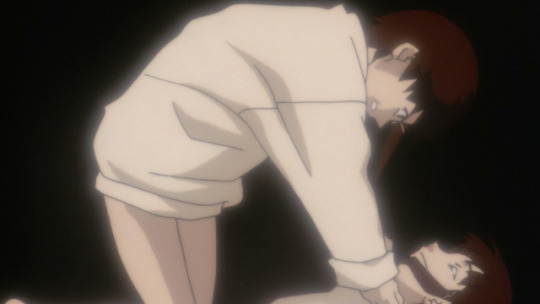
Lain confronts the fake Lain inside The Wired (Source: Funimation)
In an entry on his personal blog, Konaka writes that Lain was initially planned as an interface-heavy game for the PlayStation, which didn’t offer him many scenario writing opportunities. It was decided a 1998 late-night anime would be produced to promote the game, which would offer Konaka ample space to explore Lain’s world with fewer constraints. This approach to scriptwriting led to Lain’s infamously ambiguous story structure, which centered on Lain gaining access to The Wired and the various anonymous organizations vying for power within it. Unlike the PlayStation game, which relied heavily on players navigating a complex system of computer files about Lain, Konaka’s anime adaptation provides an intimate over-the-shoulder perspective. Lain, an introverted young girl, is quick to embrace a myriad of “other” Lain personae online. In episode 8 "Rumors," Lain returns to her own reality after confronting and attempting to kill one of the fake Lains in The Wired — only to find yet another "fake" Lain has somehow planted herself among her friend group. Whether it's a hallucination or not, it's a jarring moment of emotional whiplash and confirms Lain's fears aren't just online, but that her anxieties over her identity are becoming very real.

A "fake" Lain from The Wired among her real-world school friends (Source: Funimation)
For Lain, it becomes increasingly difficult to determine whether or not people like her or the internet's perverted image of her. The uncanniness Lain experiences isn’t a fear or helplessness to an almighty force or evil corporation like other cyberpunk stories. Rather, Lain’s biggest fears are these alarming encounters with her split virtual personalities — a stark reminder of who she may become after the inevitable collision between The Wired and reality. In the end, she is her own worst fear.
The Lovecraftian Connection
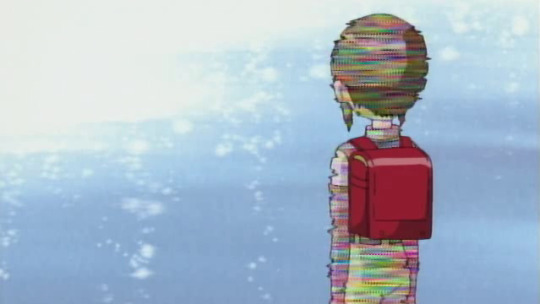
Gatomon watches Kairi "glitch" as she wanders across the street in a daze (Source: Hulu)
Although Konaka has certainly gained a reputation for his work flirting with cyberpunk, it’s by far no means the only format capable of unpacking these complicated themes of self-realization. Like many fascinated by the weird, Konaka is famously fixated on the works of American horror writer H.P. Lovecraft. It could even be argued Konaka is just a horror writer flirting with hybrid supernatural science-fiction. Much like the genre-omnivore his early writing credits would imply him to be, the way Konaka has approached a score of fantasy and cosmic-horror lend themselves to a far more liberal application of Lovecraftian tropes. This, of course, has given us some of the most unlikely mash-ups of thematic material, such as his episode “The Call of Dragomon” in Digimon Adventure's follow-up, Digimon Adventure 02.
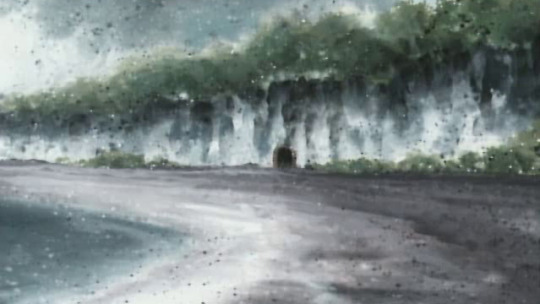
The cave beside the mysterious Dark Ocean (Source: Hulu)
Obviously, a reference to Lovecraft’s 1926 short story “The Call of Cthulhu,” this episode was initially conceived as the starting point for an eventually abandoned story arc about the mysterious Dragomon entity. As if this didn’t make the episode interesting enough, it’s significantly darker in tone compared to the series’ typical upbeat mood. Kairi, an otherwise confident and outspoken girl, suddenly develops strange dreams and Lain-reminiscent behavior. Kairi eventually begins to develop hallucinations about being underwater and being watched. Eventually, she finds herself staring out at an ocean and exploring a dark cave — somewhere neither in the Digital World nor the real world. This is when things get uncomfortable — even in a reality where traveling between cyberspace and the real world is possible, there are still unknowable “in-betweens” yet to discover. Again, the slow unraveling of horror isn’t the reveal of Dragomon, but rather Kairi’s atmospheric aloneness in realizing the reality she’s taken for granted can suddenly be uprooted without warning. Classic existentialist cognitive dissonance. But, y'know. For the kids.
No One Can Hear You Scream in Cyberspace

Jeri is psychologically tormented by the D-Reapers and relives her mother's death in the hospital (Source: Hulu)
After Digimon Adventure 02, Konaka would continue exploring this theme of protagonists inadvertently entering “new worlds” and having to reconcile their identities as a consequence. Like Lovecraft’s characters uprooted by the mere knowledge of cosmic horrors in isolation, Konaka’s characters must sink or swim when it comes to reality-shattering revelations. Konaka’s writing on 2001’s Digimon Tamers strongly flirts with these ideas, going beyond a simple “deconstruction” of the series’ basic premises toward a more psychological direction. Although Tamers' main protagonist Takato is himself an idealistic fan of an in-universe Digimon franchise, Tamers doesn’t forego the very real consequences of abruptly being spirited away to a violent new world. The kids aren't simply away at summer camp anymore — after a few dozen encounters with god-like creatures, the mental strain begins to slowly creep up on the DigiDestined. Rather than escaping without consequences, Konaka’s DigiDestined have to face the music and realize their escapist fantasies about Digimon aren’t what they imagined. This version of the Digital World isn’t morally flat, but something borderline Eldritch that becomes fully realized in the series finale.
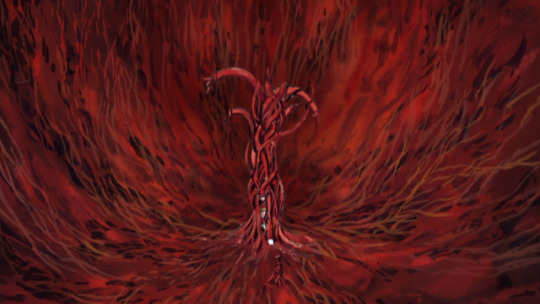
Jeri captured by the D-Reapers with Calumon (Source: Hulu)
In Tamers' climatic arc, Jeri, Takato’s eccentric classmate and fellow Digidestined, is abducted by man-made programs called “D-Reapers” as they take over the city. The D-Reapers, who intend to eliminate both the human and Digimon world, attempt to transform Jeri into the “Mother D-Reaper” by channeling the traumatic memories of her mother’s death. As notorious as Tamers' ending has become, it's perhaps not as brutal in the broader context of Konaka’s work. While captured, the D-Reapers keep Jeri in a Nyarlathotep-like cyber-flesh tower — similar to Tsukamoto’s half-man, half-machine character from Tetsuo: The Iron Man. Jeri doesn't have the intermediary of a Digimon to help — her partner Leomon is gone — and therefore has to face the unintelligible cosmic-cyberpunk D-Reapers alone. The “real” Jeri is momentarily gone. Like Lain’s lost identities in The Wired. Again, an adolescent protagonist must face the horror of losing one's self in a world with no logic. For a moment, she becomes truly hopeless, believing that this is "fate," recalling the phrasing doctors used described her mother's death. Thankfully, Jeri recovers and reunites with her friends as the equilibrium between the Digital World and reality are stabilized. But the point still stands: Our most intimate fears far surpass anything else we can face in the most alienating of scenarios.
The Petty Exorcist
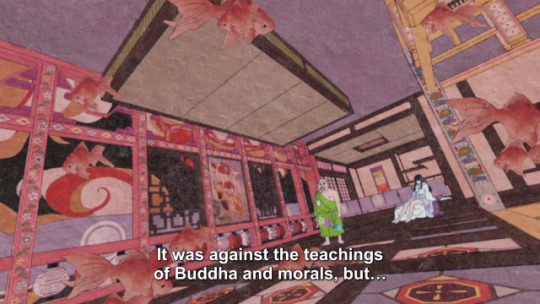
Genkei confides to The Medicine Seller aboard the ship
Beyond flights of cyberpunk cognitive dissonance fancy, Konaka’s work on the 2007 series Mononoke draws a more direct line back to his origins in Japanese horror cinema. A spin-off of the Ayakashi: Samurai Horror Tales series, Mononoke focuses on a pointy-eared man known as the “Medicine Seller” and his mission to terminate malicious spirits called “mononoke” across feudal Japan. Konaka’s story-arc “Sea Bishop” pays homage to classic funayūrei (boat spirit) ghost stories with a whodunit twist after someone sabotages the ship's navigation. Having wandered into the Dragon Triangle, a dangerous part of the Pacific Ocean full of evil spirits, a monk aboard named Genkei is suspected of the deed. Rather than immediately deal with any suspected mononoke, the Medicine Seller must decipher the true reason Genkei led them astray — his challenge isn’t an exorcism, but rather distinguishing petty human lies from truths. Genkei explains he did so to free his sister's spirit, who was supposedly sent to sea in his stead as a human sacrifice. Up to this point, Genkei’s intentions seem noble until his manipulative past is revealed: He had been fighting incestuous thoughts and guilt for years, having only become a monk to cope with his feelings. His sister died in vain.
The True Face of Horror Is Your Own

After the Medicine Seller reveals he knows someone is lying on the ship, Genkei gives his confession
Satisfied with Genkei's understanding he has been living a lie, the ship's mononoke finally emerges to be slain. It’s only this expulsion of a private fear that allows the Medicine Seller to finish his work. This time, no one is being manipulated by spirits or supernatural entities — all that remains is one person's terrifying inability to see beyond the lies they forced themselves to believe. The "real" you is worse than anything you can imagine.
Konaka’s fiction rarely gives us easy answers. While his work may seem oblique and impenetrable at first, these are fundamentally stories about people’s biggest fears being themselves and what they believe they know to be true. Although the novelty of being whisked to a fantastical world is alluring, Konaka doesn't downplay the expected alienation and anxieties of his characters. For as wide-ranging and genre-agnostic as his many series are, they never lose track of what fundamentally makes this flavor of horror unique: an embrace of the uncanny, the bizarre, and unflinching honesty.
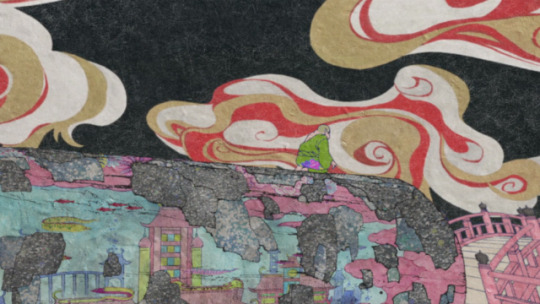
What spooky anime gives you nightmares? Let us know in the comments!

Blake P. is a weekly columnist for Crunchyroll Features. Impmon did nothing wrong. His twitter is @_dispossessed. His bylines include Fanbyte, VRV, Unwinnable, and more.
Do you love writing? Do you love anime? If you have an idea for a features story, pitch it to Crunchyroll Features!
18 notes
·
View notes
Text
Review 2 of 2

I know it’s been a month since part one of this review (which you can read HERE), but I had to collect my thoughts on this book! Not because I had mixed feelings about it - it’s honestly one of the best books I’ve ever read - but because it made me so emotional. I did write a review on Goodreads, which I’m posting below, and after that I’ve included several passages that moved me as I read. I marked a LOT of them (sorry, library), so I hope I can narrow them down. Having said that, this will get long, so more under the cut!
Tagging: @snowbellewells @reynoldsreads @whimsicallyenchantedrose @ekr032-blog-blog @superchocovian @lfh1226-linda @nikkiemms @thislassishooked @branlovestowrite @tiganasummertree and I thought of you @distant-rose for the way Joy fell in love with England just as much as with Jack :)
****I guess you can say there are technically spoilers beyond this point, but since this is all historical information, many may already know these details. ***
Before I get into that though, I want to clarify a few questions I brought up when I was only half way through the book. I wondered about their letter writing and why those letters were destroyed. Turns out CS Lewis burned all of the letters he received because people wrote to him about very personal things, and he didn’t want those being published after his death. So, that makes sense, I guess, though it still doesn’t explain what happened to the letters he wrote to her, unless he burned those too after her death for the same reason. Jack (what his close friends called Lewis) had a civil marriage with Joy first because of immigration issues, and she and the boys lived in a separate house. However, they still spent a lot of time at the Kilns (Lewis’s home) and lived there briefly at different times. Their relationship, according to most sources, wasn’t physical at that time (however, does anyone really know for sure except for the two of them?), and the book depicts it that way. The church refused to marry them because Joy was divorced, and this was a major issue for Jack due to his faith. Only after a sympathetic priest married them in a hospital did they consummate the marriage.
The major source material for this book was an unpublished manuscript called Courage containing forty-five love sonnets Joy Davidman wrote to CS Lewis. David Gresham, Joy’s son, found them in the back of a closet in 2013. Most of the chapters in the book start with lines from these sonnets. And these sonnets are definitely intimate and passionate. I’ll confess, it’s a little weird when you imagine that famous picture of CS Lewis we’ve all seen a million times, bald headed with his pipe. Like reading sexy poems someone wrote to your grandpa. Nevertheless, the love story crafted in this book was breathtaking.
Here’s the review I wrote on Goodreads:
I almost don't know where to start with this book, it was so good! The writing style, the phrasing, the characterization, it was all stellar. I felt like I knew Joy personally reading this. I also loved how the author didn't romanticize Joy or Jack (C.S. Lewis). She wrote them flaws and all, including their physical traits. This isn't Hollywood, air brushing the protagonists so they fit society's definition of "sexy." This book proves you don't need attractive people to tell a passionate, romantic love story. Love is so much deeper than that. I think that can sum up this entire book: love sees past our flaws; love is attracted to our minds and our souls, not just our faces and bodies; and love blooms best when it's rooted in a strong friendship.
This book also tackled the sexism rampant in the 1950s and how that impacted Joy, who broke the mold on what a woman should be. It makes you realize how the social norms of the day influenced Lewis's friends and their opinions of Joy. (Tolkien despised her.) You also feel Joy's oppression under these expectations and understand why Jack's friendship meant so much to her. He viewed her as an intellectual equal, something she was desperate for. I also was heartbroken over the poor medical care she received simply because she was a woman, with the doctors often completely ignoring her to address the men in her life and making light of her symptoms. Today, she might have lived.
I refuse to read other reviews because I have a feeling many Christians won't like this book. Joy is not a sanitized Christian heroine. She would definitely fit in more with the "bad girls" of the Bible like Rahab and the woman at the well than she would with Sarah or Hannah. She was a real person who came to faith late in life. She made mistakes even after her conversion, and some of them will make the reader uncomfortable. There were a lot of gray areas in her life and in her relationship with Jack that aren't easy to grapple with. So if you're looking for a black and white, squeaky clean, shining beacon of virtue you'll be disappointed. But if you're willing to take the journey with Joy, it's a fantastic tale!
Now for some of my favorite passages! (The book is in first person from Joy’s point of view):
“What could I have done differently? I begged the tortured Christ in stained glass.
My parents had warned me - Why can’t you be softer, nicer, and kinder? Prettier? More like Renee? {Renee was a cousin and one of her husband’s many affairs.} Why couldn’t I? Was this my punishment for such self-will?”
“I stayed and felt the enormous noise vibrate through my body. Chills ran through me, and I shivered with the unceasing sounds, which were cleansing me, coursing through my veins, through my mind and my spirit. The tenor and fifth ringing together, not synchronized or in harmony but in perfect sublime sound. My boundaries dissolved; transcendence enveloped me. God was with me, and always had been. He was in the earth and the wind, in the ringing and the silence, in the pain and in the glory of my life.”
“In his office Jack didn’t just read; he went deep inside the work his eyes fell upon, taking apart the sentences and themes. And while I was nearby, he would often call my name.
‘Joy,’ he’d say, ‘what do you think . . . ‘
Off we’d go into a theological or thematic discussion. Sometimes I feared I would wake and be back in the rambling, falling-apart house in Staatsburg, Bill stumbling drunk down the hallway smelling of sex and whiskey, and find my time with Jack had only been a dream. But instead I sat in the armchair of his office at the top of the staircase discussing the meaning hidden in stories.”
“It’s not an apology, Jack. Can’t you see? It’s grace, the kind that hunts us down and doesn’t let us go. It brought us together. The grace that keeps the planets in their orbits and causes lilies to open their faces to the sun.” I dared to meet his eyes with mine. “It’s love.”
“No.” I took another sip of sherry. “I’m confused . . . . About Jack, I don’t know. This time it’s not just about some physical need. For goodness’ sake, the man smokes sixty cigarettes a day and then his pipe in between. He’s seventeen years older than I am. But he still has this great gusto for life - for beer and debate and walking and deep friendship. Christianity most definitely has not turned him into a dud. This isn’t some lust-fueled fantasy. It’s the connection between us. The discourse. The empathy. The similar paths. This isn’t some obsession with getting something, Belle. It’s the feeling of finally coming home. It’s confusing at best.”
“Red heat filled my chest. He turned to place the sword on the mantle, and the structure of his chin, the lines of his smile, caught the firelight. A line of poetry surged forward in my mind: the accidental beauty of his face.”
“He was instantly next to me, his hands on my shoulders to spin me around to face him. ‘Don’t turn from me,’ he said. ‘I cannot bear that. If we can’t indulge in eros, surely we have all the beauty that remains in philia.’ He pulled me close to wrap his arms around me. Twilight turned to night and my head rested on his shoulder and the palm of his hand was on my neck, stroking my skin with gentleness as if consoling a small child after a frightful storm.
But this wasn’t fright he was trying to subdue; this was desire. His mind might twist firm around logic, but his body divulged the truth.
It was he who let me go, and gently touched my cheek before leaving me quaking without another word.”
“Jack was alongside me every day he came to Oxford from Cambridge, and many whispered that he’d moved in. What vivid imaginations they had.
There had been a night I thought we were on a “date” - when he took me to see Bacchae, the great Greek tragedy. In the dark of the theater he had taken my hand. With our fingers wound together and the great tragic ending of the play approaching, I believed in more for us. But, alas, after leaving that darkened theater our natural rhythms returned - philia, banter, beer, and laughter.”
“At your worst?” He shook his head and his spectacles fell from his face, landed on the worn cream blanket covering my diseased body. “You are beautiful to me, Joy. You are all that is beautiful.” He tucked a stray hair back from my face. “All my life I have thought of love in a literary sense, part of a story or a fairy tale. But love is really true; I know that now. Eros - I haven’t loved completely until now. I know that.” His voice held the truth of every word spoken, a man broken by death’s threat.”
“He kissed me again. ‘Everything I’ve written since the day you walked into Eastgate has been tangled with you. How could I have not seen it at all?’”
“Will you go to them?” I took his hand in mine. “They need you, and they love you, Jack. You know that, don’t you?’
‘As I love them.’ He kissed me and left as a father to my sons.
“All the years wasted believing that love meant owning or possessing, and now the greatest love had arrived in my greatest weakness. In my supreme defeat came my grandest victory. God’s paradoxes had no end.”
“I didn’t know if others understood his deep love for me. I’d wondered and then let it go - it didn’t matter what Tollers {Jack’s nickname for Tolkien} or the Inklings or the Sayers believed. Maybe Jack had admitted his love or maybe he hadn’t, but all that mattered was that I grasped the truth. He loved me when I was brash. He loved me in my weakest state. He loved me after I stopped trying so hard to make him love me. He loved me when I was outwardly unworthy. I thought of Aslan and his words in Prince Caspian, ‘You doubt your value. Don’t run from who you are.’”
“His brown eyes seemed fathomless, their depths holding the answers. ‘Although it was your mind I loved at first, it is not what I’ve loved best. The heart of you is the heart of me now, and I want to know it fully.’”
6 notes
·
View notes
Text
Gallius Rax is Alive If I Want Him To Be: a forced analysis of “The Starship Graveyard” from The Legends of Luke Skywalker
One of the short stories, from the anthology series of probably apocryphal, second or even third hand accounts of Luke Skywalker, is about the Battle of Jakku. This is a story that was “passed from teller to teller” and was originally told by an imperial officer. It could be all fiction, or based on some true event. Bits of it could have been changed in retellings.
In my humbol opinyon the character believed to be Luke could actually be Rax, if he survived his injuries, possibly by supernatural means. If it were him, he’s clearly been changed by the experience and is trying to atone for his evil.
A lot of the Legends of Luke are clearly about Luke, whether they’re true or not. But this story has a character presumed to be Luke who actually acts very unlike Luke in personality, and isn’t doing anything Luke would be doing if he really were there at the Battle of Jakku.
TL;DR: A young imperial officer, after his ship crashes on Jakku, is rescued by a mysterious scavenger who is extremely resourceful and knowledgeable about survival on Jakku, and takes the officer to the secret base Rax commands from in Empire’s End. The officer thinks he’s met Luke Skywalker. The strongest piece of evidence in favor of it being Rax is that the man is able to access Rax’s own quarters at the base, when no one else from a large group of scavengers is able to get in. Also, symbolically and thematically, the officer believes certain things about the man (as Luke) that come very close to the truth of Rax’s role in the battle.
Let’s go over the story. The protagonist is a young Imperial gunner on his first tour of duty. He describes the battle as intended to be a “textbook grand battle, a confrontation between the good of order and the evil of anarchy.” This is in line with the speech Rax gives to rally the troops. It’s possible then that this character has seen Rax as a hologram giving that speech, but since Rax prefers to be cryptic and hidden, and he changed his title from fleet admiral to “Counselor to the Empire” before taking the fleet to Jakku, and the protagonist later suggests he is unfamiliar with the desert landscape, it stands to reason he wasn’t part of the initial fleet that Rax brought with him and “sharpened” through exposure to Jakku’s harsh environment. His ship might have arrived late, for the battle itself. So we could imagine he wouldn’t know Gallius Rax if he met him.
At some point in the battle, his ship is damaged and starts to crash. The protagonist hits his head on a console.

I mentioned earlier that this man (let’s call him POV Guy) might have only seen Rax as a hologram. He’s already injured, not able to see well. This might have actually been a hologram of Luke, but since this story was told and retold, who knows? The man in the hologram could have resembled the man POV Guy meets, and POV Guy believes he met Luke, and the story rearranges itself from there.
POV Guy sees some strange things, watching the battle through the windows from his spot on the floor: it seems like the hologram is firing bolts of energy at the Imperial ships.

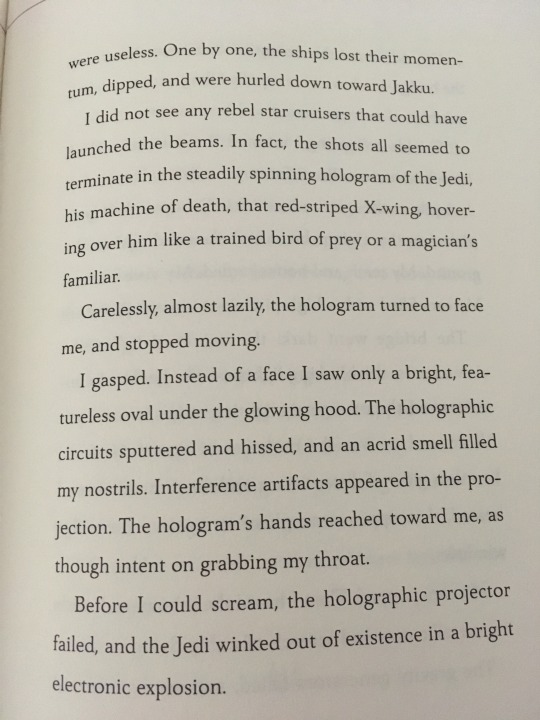
My assumption will eventually be that the man POV Guy meets is not Luke. The hologram could have been of Luke, with POV Guy seeing a very vague resemblance (he doesn’t even see hologram Luke’s face). The image of the hooded figure with a featureless oval for a face reminds me more of the Sentinel droids, the Palpatine-bots who help carry out the contingency plan. As opposed to a wanted poster of Luke, or a fragment of Rax’s speech, could a hologram of one of the Palp-bots be what the man was actually seeing?
Anyway, whatever this guy sees leaves an impression on him that has more vibes of Palpatine’s contingency than Luke Skywalker, because POV Guy, right before the ship finally hits the ground, winds up believing the battle was “not a fair fight” because of some magical interference by the hologram man. And he’s right, the battle was a ruse and the Empire ships were meant to be destroyed along with the rest of the planet by ancient Sith magic as part of the Contingency. So POV Guy seems to grasp something about the battle, and attributes it to Luke Skywalker where it best describes Rax (and Palpatine as his puppetmaster): the scary figure using magic to bring the Empire down. Already there’s a basis to the argument that POV Guy has in some way mixed up Luke and Rax.
POV Guy briefly wakes up in the wreckage and sees some dead bodies of other imperials, and faints again.
He has a fever dream where Luke is running around in space with his lightsaber taking down starships.

Interesting how he dreams of Luke basically wielding Force lightning, which is much more reminiscent of Palpatine. Also, the ones who dragged ships down to Jakku with tractor beams were Rax’s most loyal fanatics in the Empire. So again, Luke as the malevolent god of this scenario is taking over the role that would best be ascribed to Rax and the Contingency.
POV Guy wakes up on Jakku again at night. He eventually realizes he’s being dragged on a litter with a lot of other scrap materials. The man dragging him is wearing some kind of robe.
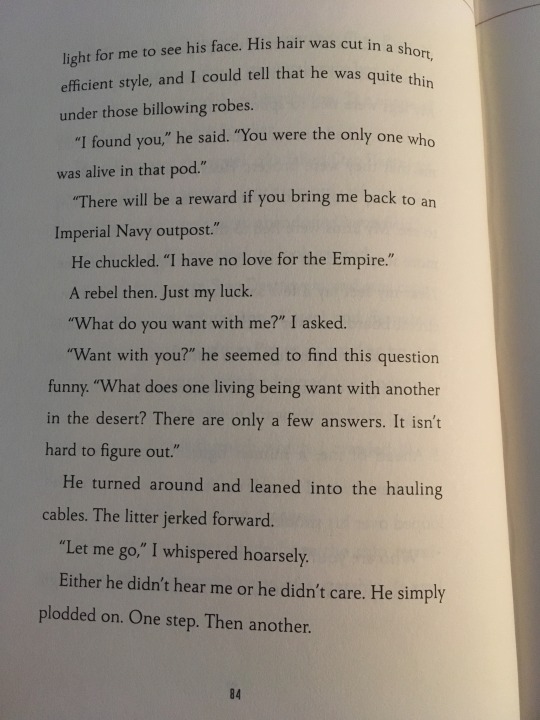
Hair in a short, efficient style, and a thin frame, would not rule out Rax. In particular, because Rax seems to have starved himself over his time on Jakku, and Luke might not be described as especially thin.
from Empire’s End, describing Rax:

Also, the man saying he “has no love for the Empire” with a chuckle gives the impression he’s concealing some dramatic irony. He’s probably not a rebel from the battle, because he’d just say so. He might be a civilian from the planet. But maybe there’s something unusual about his relationship to the Empire.
“What does one living being want with another in the desert?” doesn’t sound like Luke at all. It does sound a lot like Rax, who talks like this a lot and whose whose philosophy likes to frame itself based on what living beings want from one another in the desert (survival of the fittest, vworkka and skittermouse, etc). Also strange for Luke, this man sounds like he’s riling POV Guy up, letting him think he’s in danger, instead of immediately reassuring him.
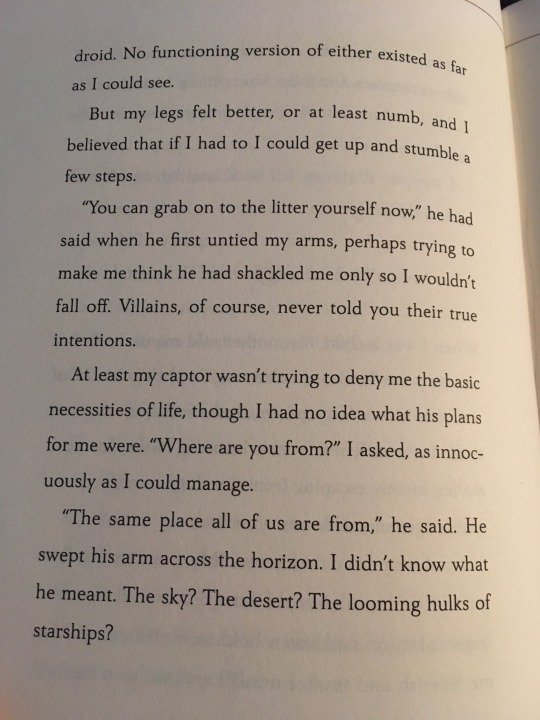
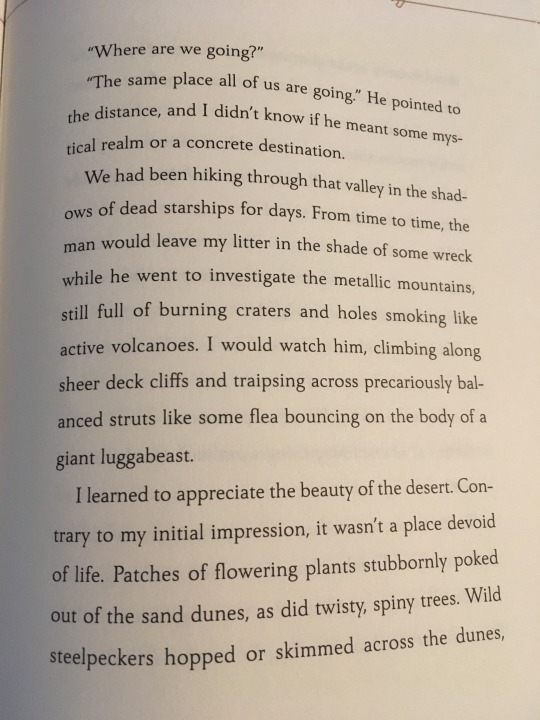
The man is cagey about answering where he’s from. If he’s Rax, he is in fact from Jakku and has always been vague and cagey about it when asked direct questions about who he is. A random scavenger or Luke might also put on an air of mystery. But the question is most ironic if it’s Rax.
POV Guy spends a few days being carted around, while the scavenger scavenges and apparently looks for other survivors. POV Guy also finds spots of beauty in the desert. In my reading of this where Scavenger Guy is Rax, it relates a bit to how Rax’s villainy feels tied up in how dead and desolate Jakku is. The world is depicted as unbearably hellish in Empire’s End, and Rax in particular thinks it’s sucking him dry. But here, we see it showing bits of life. If Rax is alive because he died close to that borehole emitting glowing Jakku Life Energy, he might be linked somehow to the planet and its life force. And if he’s not being evil anymore, the planet’s good side might poke through a bit. Rax does like flowering plants.
Scavenger Guy tells POV Guy to stay put while he goes and gets some more scrap. POV Guy takes this as his chance to try to escape, because he assumes the worst of his savior/captor. He grabs some supplies and arduously crawls off, but notices a dark storm cloud approaching. He hides a little ways inside the thruster nozzle of an Imperial starship.
Scavenger Guy shows up.
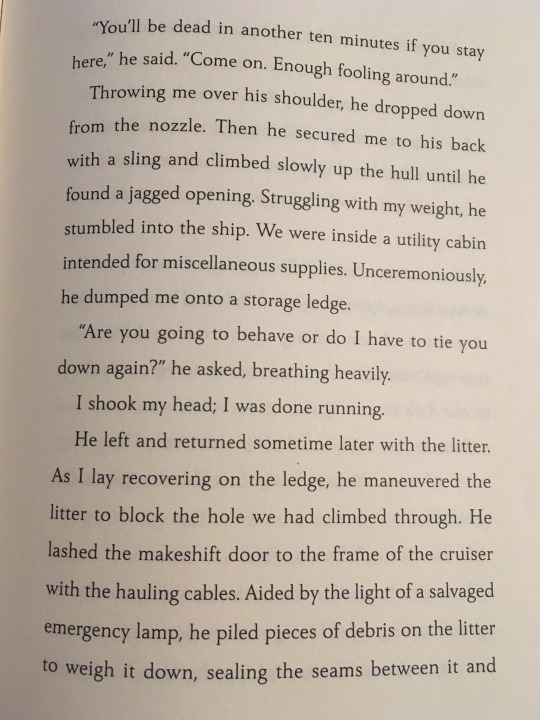
Scavenger Guy is clearly very resourceful from how he sandstorm-proofs their shelter. He’s also still curt and vague with POV Guy.
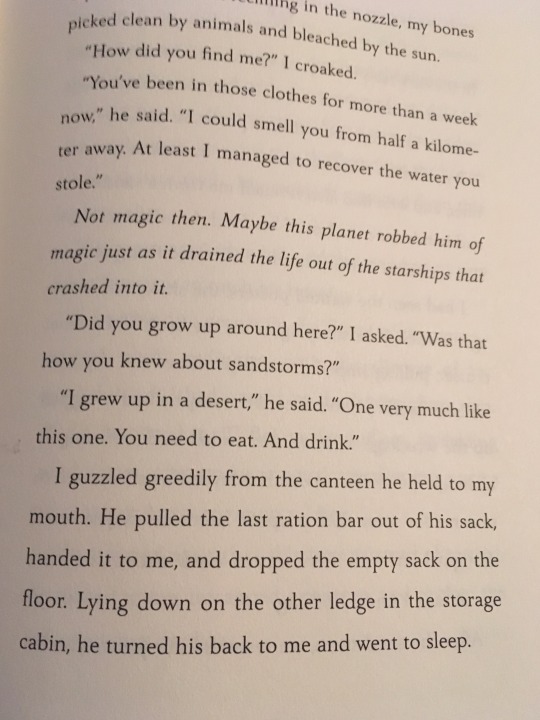
This would lead us to think of Luke, who grew up on Tatooine. I would imagine Luke would also know what he’s doing. But Rax would obviously know how to survive a Jakku sandstorm as well. He’d also, again, be the sort to dodge any direct association with Jakku. If it’s Rax he did literally grow up right in this exact area of Jakku and spent a long time guarding it, and probably scavenging too as he killed intruders.
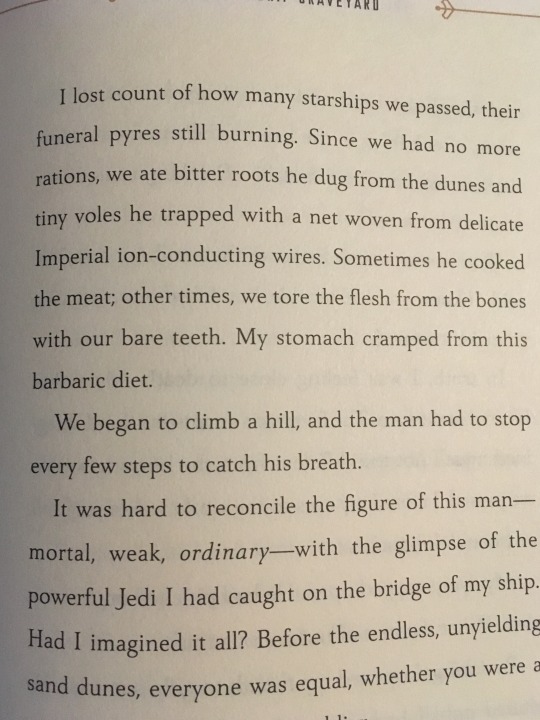
This is still exactly the sort of thing I’d associate with Galli’s survival skills. He knows what particular weird desert plants to find around here, and is up for devouring rodents raw. Highlighting that, calling it barbaric, keeps giving off Rax vibes.
Scavenger Guy tries to get POV Guy to have a sippy of some water. POV Guy gets skittish and dodges him for a bit.
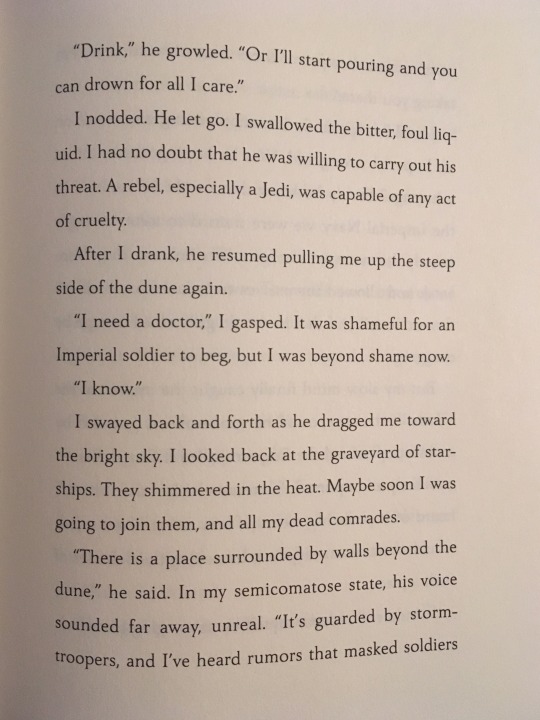
Again not exactly Luke vibes. Scavenger Guy is trying to be helpful but he’s lapsing into villainous threats.
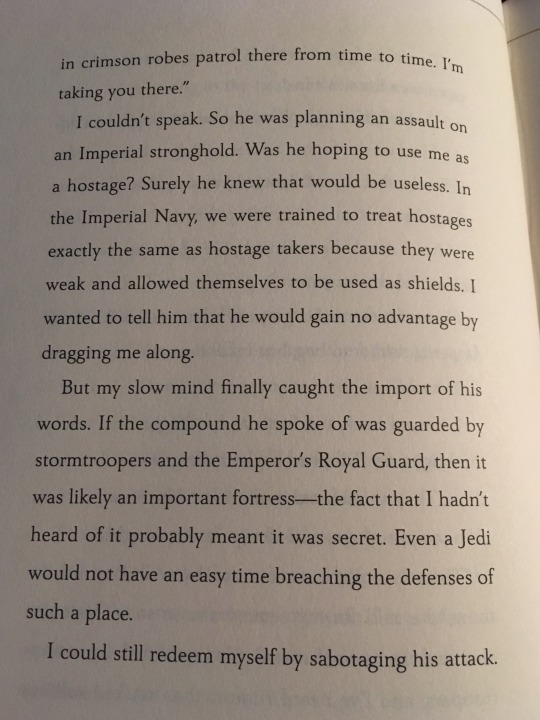
And this is where it gets VERY interesting because it sounds like he’s headed for either the Observatory or the base Rax hung out at.
Luke has actually been to an Observatory elsewhere, so there’s reason to believe he would be one of the people to find it secret facility. But so far, he hasn’t seemed much like Luke. He’s genuinely scavenging for scrap, wasting a lot of time on this one man and this one planet. Luke has better things to do. But would a random scavenger find the Observatory, or the main compound, and be confident about getting in?
But of course Rax would have no trouble at all.
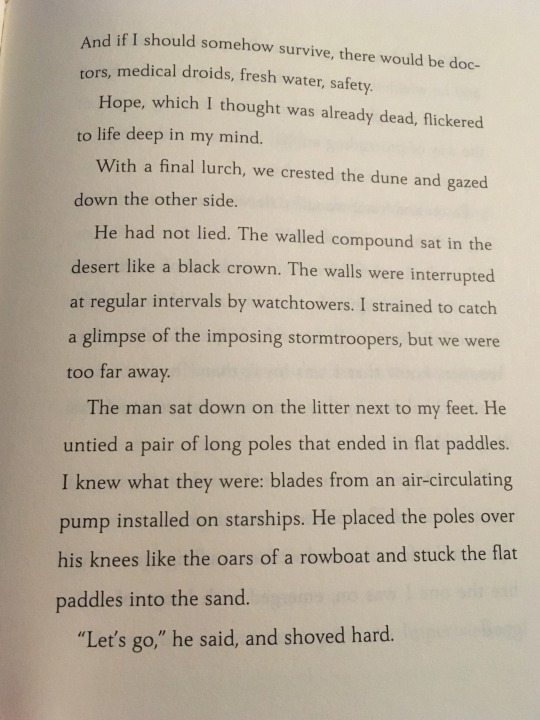
It’s described more like the compound (the Observatory is smaller and mostly hidden underground). It turns out that no one is guarding the place and it’s full of refugees. Why did Scavenger Guy say otherwise? What if the place actually was guarded, though? Those guards would definitely only respond to Rax. He could have ordered them to stay far away while he ran it as his own little anchorite habit house I mean charitable institution I mean redemption den I mean refugee camp.
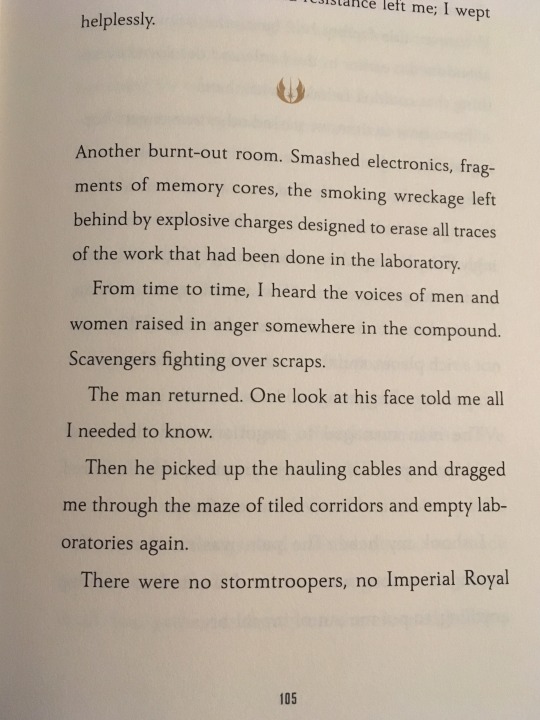
The mention of a laboratory with everything specifically destroyed to hide evidence feels more like the Observatory. Again, this story is many degrees of separation from a narrator who would be unreliable to his own mind. But whichever it is, it’s one of Rax’s stomping grounds.
After a while, they hear a big explosion and it turns out one of the nearby star destroyers has exploded and turned into a lake of lava.

Now the idea that a ship can turn into a whole lake of lava from having a reactor meltdown is odd. You’d think it would happen all throughout Jakku, then. But maybe the ship just exploded — and opened up one of the fissures that was forming from the borehole being activated. Again, this might be the Observatory but if it has an observation deck (”overlooking the compound” at the top of the page refers to a balcony), ironically, it’s probably not — that deck might be where several days prior Rax left Sloane and Brentin so they could watch the battle and despair, and the compound is indeed closer to the battle than the Observatory. The Observatory is a little ways away, but it’s close enough that its bomb mechanism could have brought a lot of lava to the surface of this region. This lava might be tectonic activity, not just the ship.
Anyway they’re all trapped in the compound because of this lake of fire, and it’s going to collapse the facility. Scavenger Guy sees the danger and eventually disappears for a while. Everyone waits for impending doom.
Then Scavenger Guy shows up with those big flat fan blades and uses them like snowshoes or water skis to walk on the molten glass.
POV Guy: OMG. Skywalker. I get it!
Scavenger Guy convinces everyone they can evacuate by making rafts, boats, and shoes like his.

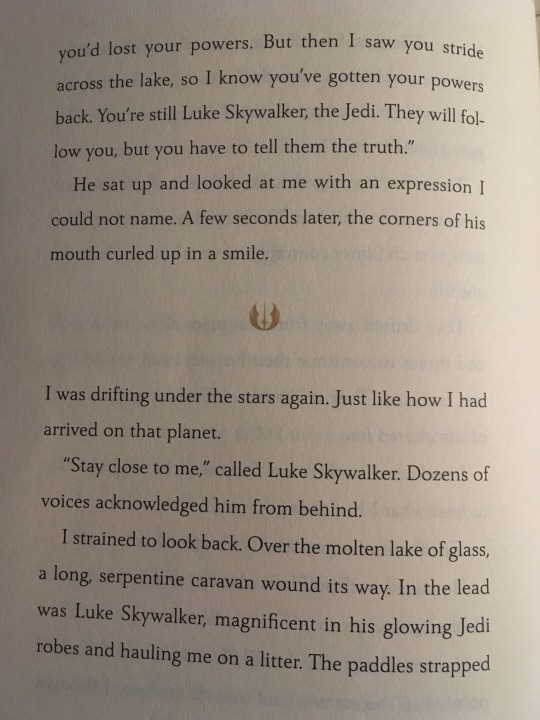
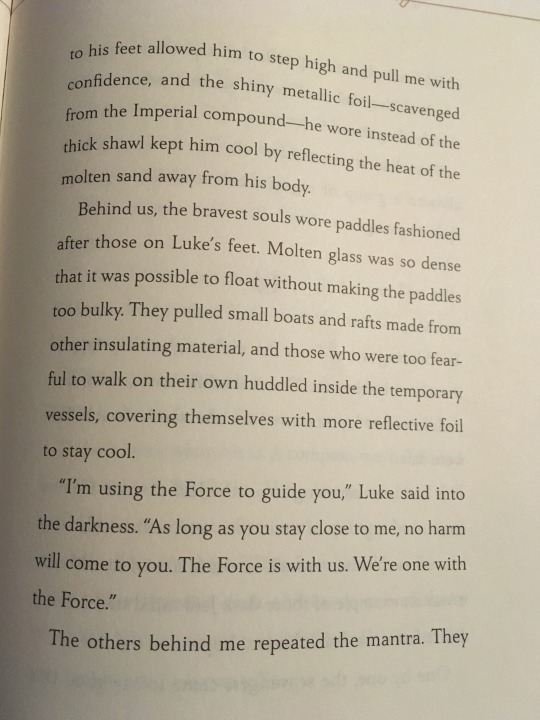
And Scavenger Guy only starts claiming to have the Force after POV Guy says he’s Luke. It really does sound like he’s making it up as he goes along. He’s playing it up for drama.
They make it out of there and everyone thanks Scavenger Guy and leaves him gifts as a reward. Then Scavenger Guy talks to POV Guy again.

Before parting ways, Scavenger Guy gives POV Guy some special resources from “the compound commander’s quarters”. That’s Rax’s quarters, by the way. He’s apparently the only one of the scavengers who is able to access Rax’s quarters. No one else got in. Is he just exceptionally skilled at slicing? Or was he, you know, the compound commander himself?
Also he knows the specific names of more Jakku wildlife.
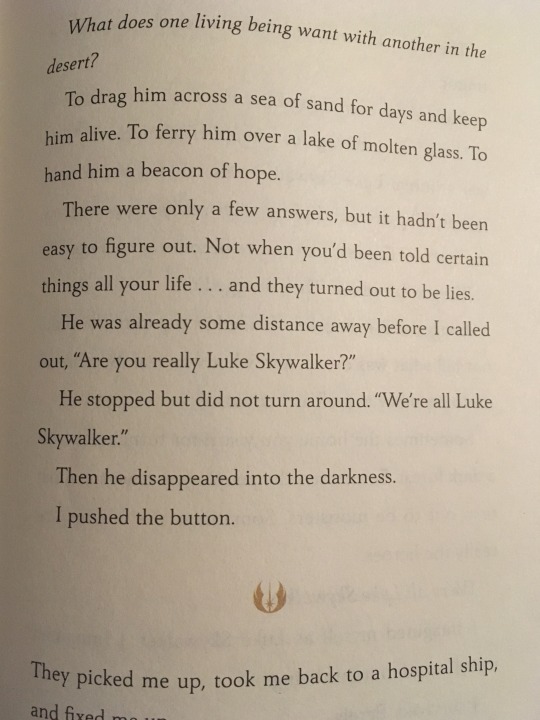
We’re all Luke Skywalker, huh? Is that going to come up in TROS?
So basically if I’m rolling with my headcanon, that would mean that Rax promptly woke up from being killed, and scavenged himself a redemption arc of some kind. Which is a pretty huge concept! And of course I have no idea if all the similarities are a coincidence, and they probably are. But you never know. The story does also later include the line “villains can be heroes” as POV Guy thinks about his time with “Luke Skywalker”.
Anyway shoutout to this headcanon version of Rax for improving himself as a human being 11/10 extremely unexpected redemption
#LONG post under the cut very long#gallius rax#aftermath trilogy#legends of luke skywalker#hhhhh h what am I doing with my life
7 notes
·
View notes
Note
I was thinking about AOT and the first chapter: Eren was crying, probably about what he experienced or will experience before the story ends and the memories will be stored in the attacking titan. That's how Kruger knew about saving Armin and Mikasa before it even happened. However in Eren's dream there is also a moment with possibly Mikasa saying "see you later Eren". I know people disagree on which Eren it's about (Kruger or Jaeger) but actually I was thinking that since (1/2)
it’s the only memory he gets from that dream, maybe it’s a sign that eremika is really going to be plot relevant. Why would he remember Mikasa in particular (and not Armin for example), assuming these memories were really about him and Mikasa? I’m so sorry if this doesn’t make a lot of sense, I love your snk posts so I wanted your opinion. Have a great weekend!
Hello anon! I am happy you enjoy my posts! And don’t worry, your ask makes sense, but since my answer is gonna be pretty long I’ll break it into two parts:
1) Firstly I will address the scene you mentioned and some theories about it.
2) Then I will talk a little bit of Eremika.
1) I agree with you that this scene
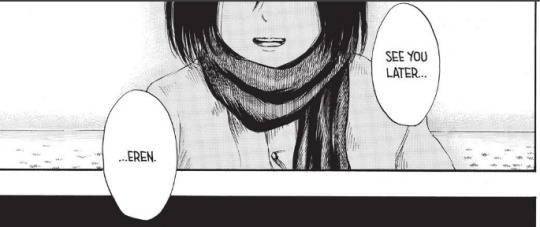
and this scene
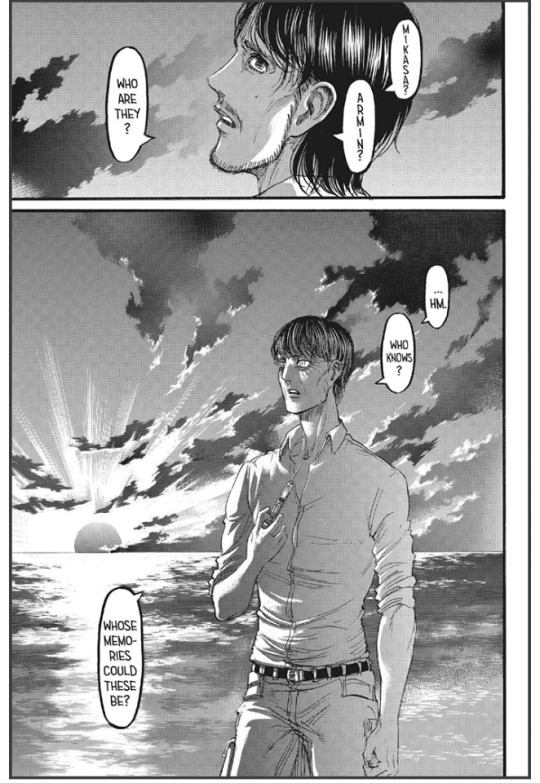
are both linked to a common plot point which has to do with some worldbuilding elements like the paths among Eldians, the origin of the Founding Titan, the Attack Titan and the truth about Ymir. Until these details remain unknown it is difficult to come up with a perfect explanation for these panels.
You mentioned two theories in your ask:
a) The girl Eren sees in the beginning is Mikasa.
In this case Eren is definately seeing his future and probably him separating from Mikasa since the girl’s words sound like a goodbye. If it’s so then we are inside a time paradox. I have seen people reading the time paradox as a negative loop i.e. a situation where our characters keep struggling, but are never able to overcome tragedy and so Eren keeps living again and again the same experiences in the hope of finally breaking the cycle. People who believe in this theory seem to think that we will either get a bad ending (so the end will be like the beginning with Eren waking up under the tree and the story starting once again without a solution) or, alternatively, we may have an ending where the cycle is finally broken and our characters are finally free to go on and to create a new world.
I would like to propose an alternative (definately crack) theory: the time paradox may actually be a “virtuous” loop i.e. the events we assisted, despite their violence and sadness, are actually necessary to arrive to a positive ending and Eren’s final decision will be to actually accept everything that happened to him and to “send his will back in time” to influence the past events and to be sure that everything goes as it is supposed to go (i.e. as we have seen in the series). Basically I am proposing a time paradox like the one we get in the third book of Harry Potter where the characters going back in time and interfering with the past don’t actually change it, but are used to explain details the protagonists saw the first time and couldn’t understand (like the person saving Harry from the Dementors who turned out to be Harry himself).
Thematically it would be interesting for Eren’s character because he, despite fighting for freedom, is a character who has been enslaved since when his father gave him the titan power. He didn’t choose to become the Attack Titan, so in a sense he has been negated freedom since the very beginning because he isn’t given the chance to personally make that very first choice which kicked off the whole plot. For him to eventually accept what happened and to influence past events so that things go exactly as they went in order to ensure a positive outcome would be a nice touch imo. It would make the whole story a consequence of Eren’s choice and he would regain the agency Grisha took away from him back then.
b) The girl Eren sees is actually a girl important for Eren Kruger.
This theory has its own good points. First of all it’s obvious that Isayama wants us to associate Eren to Kruger:
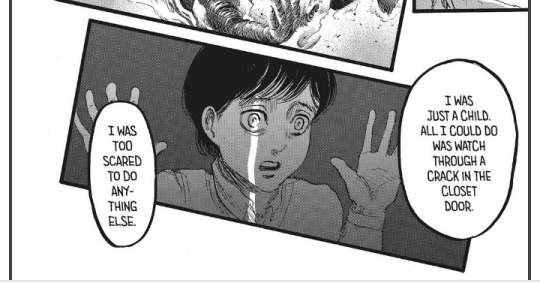
The fact that Eren used the name Kruger as his alias in Marley and their two designs as children being similar, not to count them having the same name, are all details meant to draw the reader’s attention to the connection between these two characters. If so then we can assume that this connection will be important both thematically (meaning that Eren and Kruger will be characters made to compare and contrast each other) and plot-wise. If their link is relevant plot-wise then it may not be too far-fetched to imagine that, because of some unknown worldbuilding elements (aka Eldian paths or something), the two of them share a special mental connection. This unique mental connection may explain why Kruger mentioned Mikasa and Armin despite not knowing them and why Eren got to see one of Kruger’s memories despite having still to receive the Attack Titan.
Even if this theory were correct, though, this wouldn’t change the fact that the scene Eren saw may be relevant to Eremika:

After all it’s Eren himself who associates the girl to Mikasa and this means that, in the case the girl is someone important to Eren Kruger, their relationship will most likely foil Eremika and this girl may become a parallel to Mikasa like Kruger is to Eren.
In short there is no doubt that the scene in chapter one will be, one way or another, relevant to Eremika and that Eren and Mikasa’s relationship will be (and already is) relevant for the story.
Now I’ll try to answer the second part of your ask.
2) I think that the most interesting thing of Eremika as a ship is that it has been set up to be solved only when Mikasa is able to make herself independent from Eren instead than when the two characters come together:

It’s interesting that we get to see this scene from Mikasa’s POV because we can contrast it with the dream Eren had. At the beginning of the series we have Mikasa looking at Eren with adoration and at the same time we have Eren having a vision of a girl he associates with Mikasa saying goodbye to him. It may very well have been an effective representation of Mikasa’s arc in a nutshell: the very beginning against the very end.
The root of Mikasa’s character is that she is a child who lost her family and who is terrified from the prospective of losing it again and to remain alone:

When she sees both her parents die she doesn’t even have the instinct to run for her life and lets herself get caught without opposing resistance because she has no idea how to live without her family. Then Eren comes into the scene and Mikasa clings to him:
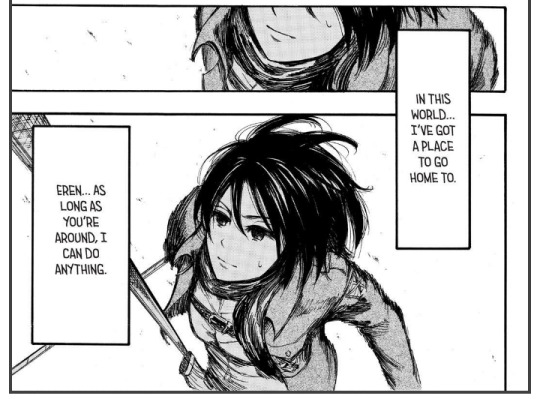
Mikasa’s clinging to Eren becomes even worse after she loses her adoptive family. Let’s also notice that for her to help Eren out was also Carla’s last wish:
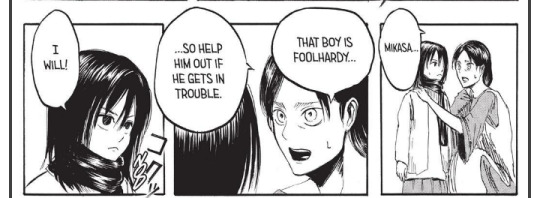
It is because of all these circumstances that we see her doing things like this in the beginning:

However, the narrative keeps challenging her on this aspect to the point that I wouldn’t be surprised if, by rereading Mikasa’s arc at the end of the series, it would turn out that the whole story was preparing her to say goodbye to Eren (and possibly to Armin):

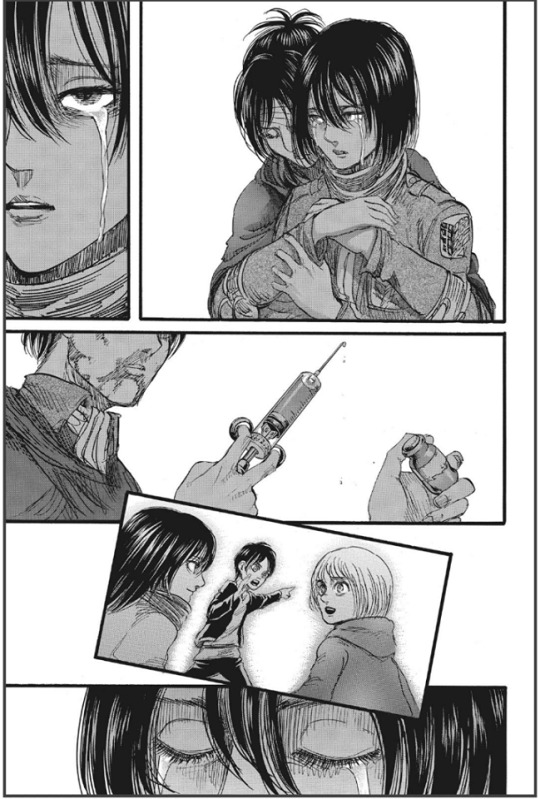
After all Mikasa has been now tricked twice into thinking that she was losing a member of the costitutive group representative of her happy childhood. To me these two occurrences seemed rehearsals to what will be Mikasa’s final trial. Moreover, she is even told that both Armin and Eren won’t live long:
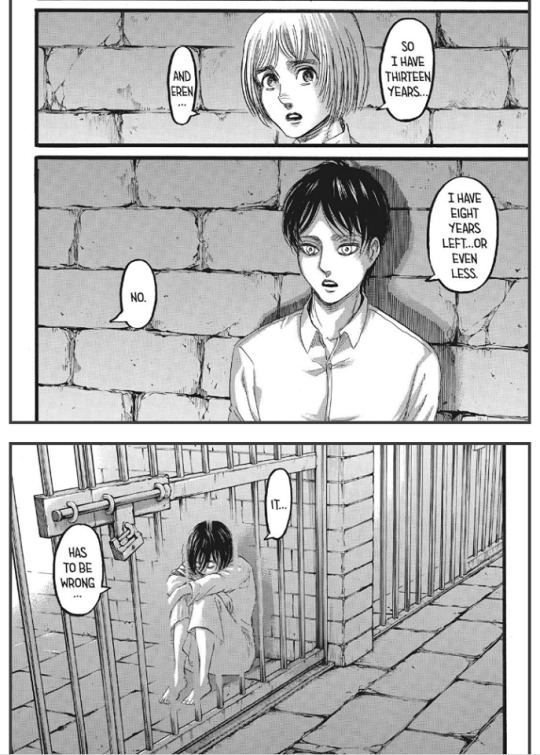
It’s as if the narrative is warning her that she has to move on and to become more independent because one’s life isn’t reduced to the family nucleus one is born in, but a person can forge new relationships and find warmth and happiness even outside it.
In short Mikasa’s story starts with her being totally unable to face a traumatic loss and it is possible that it will end with her having become strong enough to actually let go. It would be a beautiful way to end her arc imo because it would tie it back to her original trauma (her family being killed) and would solve it together with her relationship with Eren who firstly taught her that she could keep on living even without her loved ones.
What about Eren?
It seems to me that Eren is ironically doing to his friends what Mikasa did to him in the beginning:
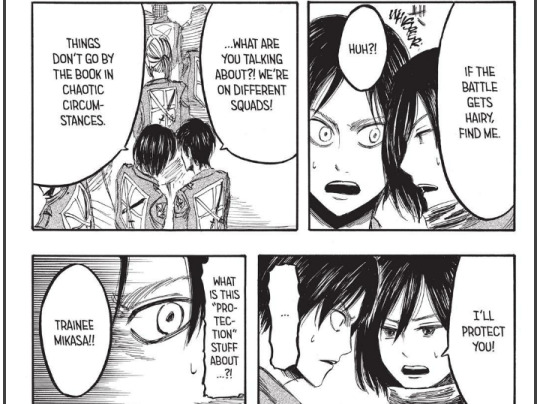
Mikasa in the beginning was constantly trying to protect Eren to the point of objectifying him to an extent and of trying to control him. Now, in the last chapter we have seen how protecting the people he cares about is still a pretty strong motivation of Eren’s character:

However, he is doing it by dismissing their opinions and their feelings and by isolating himself in the process:

It’s interesting that we see Eren in front of a mirror this chapter because the place each one of EMA is at tells us something about their current state of mind.
So we have Armin in front of an enemy trying to communicate without receiving any answer exactly like any chance of dialogue with Marley has now been lost:

Then we have Mikasa who is at Sasha’s grave, but isn’t actually looking at it (she is behind the grave and not in front of it) as if she couldn’t force herself to truly face the consequences of what Eren did:
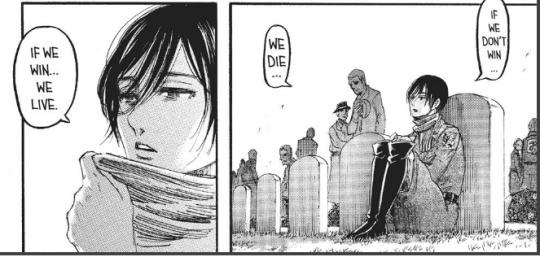
She touches her scarf instead and repeats Eren’s mantra despite Sasha’s death basically proving it wrong. They won. Sasha still died.
Finally we have Eren alone, in front of a mirror:

He isn’t seeing neither his enemies (like Armin) nor his comrades (like Mikasa), but is seeing only himself. Again, I don’t mean that he doesn’t care about others, he does, but he has assumed a self-centred prospective: he wants to protect his friends and family and will fight against whoever wants to hurt them disreguarding both who they are and what his loved ones think about the matter.

Back in Trost Mikasa was so desperate to protect Eren that she would have disreguarded her duty as a soldier in order to keep him safe and would have indirectly sacrificed others’ lives she could have saved with her strength for this reason.
In that situation it was Eren himself who woke Mikasa up and urged her to do the right thing. Now I think Eren needs a headbutt as well and it might be Mikasa the one to deliver it (since I think Armin will leave the other two). However, she will be able to do so only if she is ready to actually enter into an open conflict with Eren.
I don’t know if I was of any help! Thank you for the ask and sorry I took a while to answer it! And have a great week!
#snk#snk meta#mikasa ackerman#eren jaeger#eremika#shinjeki no kyojin#asksfullofsugar#anonymous#my meta
203 notes
·
View notes
Note
I feel like Saihara won't be well-received in English fandom. For obvious reasons, but because he's, as you say, a character who's weak and needs to rely on others constantly. Needing help sometimes is okay, but a character who always needs other more competent people to help them and who never gives back can be frustrating. Thoughts?
I think Saihara will be slightly more popular with thewestern fanbase once the localization is out, but mainly due to the fact thatthere will be less misinformation going around. A lot of the reasons I’ve seenpeople have for hating Saihara stem from wrongful assumptions that he’s a “Naegi/Hinataclone” even when he’s… fairly dissimilar from both of them, really.
I do agree that Saihara will probably never be as popular inthe west as he is in Japan, though. Personally, I like Saihara quite a lot as aprotag. Out of all the protagonists, he’s my second-favorite, with only Hinataranking higher. But I think his popularity will always be somewhat stinted bythe bait-and-switch with Kaede, which left a lot of people with a negativeimpression from the start (even though the bait-and-switch was more the faultof Kodaka as a writer, rather than Saihara’s fault).
I also think the western fanbase by and large simply prefersthe shounen protagonist archetype more. Characters like Saihara, who are weak,anxious, and dependent, are often harshly seen as “annoying” or “pathetic.”Saihara is by no means a self-insert protagonist, and he’s not supposed to be—butmore often than not, people playing a visual novel (and Danganronpa is prettymuch a visual novel with extra gameplay elements, as Kodaka has said severaltimes himself) mistake anyprotagonist for a self-insert protagonist.
Playing as a weak, cowardly, or hesitant protagonist causesmany people to reflect on the weaker, worse characteristics of themselves, andusually means they have a harder time warming up to the character than if theyexhibited traits that are seen as universally positive, like bravery, charisma,extroversion, etc.
However, it’s precisely because of Saihara’s flaws as acharacter that I’ve come to love him. For me, personally, Saihara is arguablythe most relatable out of all the protagonists—because I too know what it’slike to struggle with issues of dependency and questioning my own judgment. Assalty as I still am about the bait-and-switch, and as much as I resent a femalecharacter being fridged off for a male character’s development so early intothe game, I simply can’t deny the fact that from a thematic standpoint, Saiharais the most fitting protagonist for agame like ndrv3.
Ndrv3 is a game that challenges not only the characterswithin it but even the player themselves to constantly reevaluate theirassumptions and worldview. Because of its inherent focus on truth vs. lies,where to draw the line between those two things, and which one of the two ismore “correct,” there’s a constant sense of uncertainty throughout the entiregame. The prologue is uncertain. The epilogue is uncertain. The validity ofeverything that was said in the final trial, of the characters’ memories andtalents and backstories, of our judgment as the player in past cases, is allcalled into question.
We, as players, are tasked with solving the mystery forourselves, going back over the game and picking up on the clues andforeshadowing that Kodaka left, and trying to come up with our own theories. Ndrv3is all about the mystery genre, not only from the perspective of individualmurder cases in each trial but with the entire state of the outside world, thekilling game show, and even the characters themselves.
Therefore, the protagonist being a detective makes perfectsense. Saihara is a detective whose job by definition is to find and expose thetruth, but whose past experiences have left him traumatized by that. More thananyone, Saihara understands that the truth is painful and can be used as aweapon; he feels that he singlehandedly ruined a man’s life all because hesolved a case by accident. And yet, as a detective, he still has a naturalcuriosity that causes him to subconsciously seek these things out. He’s afraidof repeating past mistakes, and yet he can’t quite let the truth go.
This is an intentional allusion to the role of a detectivein any mystery novel: more than once, it’s been lampshaded that “the detective issomeone who brings disaster with them wherever they go.” No matter where adetective goes, a case (usually a murder, specifically) is sure to follow. Thisrole is something we’ve seen Kirigiri embrace as an inherent part of who she isin dr1 after struggling to find her memories and her purpose, but with Saihara,it’s much, much harder for him to come to terms with it. A detective who isafraid of the truth already fails to meet the criteria of a “real detective”from the start, in his opinion—and it is fascinatingto see him struggle to trust in his own intuition and abilities despite hatinghimself so much.
Saihara is certainly weak and dependent—but I’m not really surewhere you got the “never gives back” part from. Even though Saihara doubtshimself often and feels as though he’s a subpar detective and hardly qualifiedfor the job, the rest of the characters constantlyrely on him. If anything, they become over-reliant on him as a detective, somuch so to the point where it’s actually lampshaded in-game and they’re calledout on not wanting to think for themselves.
Starting with Chapter 2 and culminating perhaps with Chapters4 and 5, the characters, hell, even Monokuma, all assume that because Saiharais there “they don’t really have to solve the mystery for themselves.” This isa criticism I often see from mystery authors to their readers: the assumptionfrom people that all the answers are going to be handed out on a silver platterwithout any need to think or theorize or even try to solve the mysterythemselves first is often frustrating and discouraging to writers. And I suspectit was no accident that this sort of mindset gets deliberately addressed assomething negative throughout the course of ndrv3.
Momota and all the rest of the cast rely on Saihara to solvethe mysteries for them for most of the game, rather than attempting to dothings themselves. Rather than trusting Saihara himself, per se, it’s becausethey trust his talent, as a detective. They rely on his intuition and abilitiesso much that he actually begins becoming a little uncomfortable with ithimself.
And in Chapter 5, when at a loss for what to do because evenhe doesn’t know the answers to the case, Monokuma decides to rely exclusivelyon Saihara’s reasoning as a “SHSL Detective,” and even announces so point-blankduring the trial. When Momota attempts to keep carrying on Ouma’s bluff despitethe fact that Saihara did theorize the answer correctly, Monokuma says he’s notworried, because he’s sure that a SHSL Detective’s reasoning won’t lead himastray.
Saihara is, as Momota himself points out in the Chapter 5post-trial, “the one who was saving everyone’s asses.” More often than not, hewas one of the main figures in the group keeping everyone alive, working tosolve things when absolutely no one else was really putting much thought intothings—because they all assumed that Saihara would do it for them. To say thathe “never gives anything back” makes no sense, because in fact, it’s the factthat so much is expected from him and that he’s been thrust into such anunwanted leadership role that makes Saihara so uncomfortable and such ananxious wreck.
Certainly, having a protagonist who is weak, timid, anxious,and dependent on others can be frustrating—moreso if those things are neveraddressed within the narrative or characters constantly come to the protagonist’srescue without ever addressing the fact that they aren’t doing things forthemselves. But this isn’t the case with Saihara. Most, if not all the characters address Saihara’sweaknesses in one way or another. Many of them, like Kaede, Momota, and Ouma,work to help push Saihara out of his shell of hesitation and uncertainty.
In my opinion, having a character without any flaws at allwould be far more frustrating. A character with no flaws means there’s no roomfor development or improvement—which is, frankly… pretty boring. And there aremany, many stories in which the protagonist is often a reckless, headstrong,fun-loving person who relies on cooperation and the power of friendship tochange things (such as, most shounen stories). These archetypes can be well-written,but my point is that they’ve been done often.
It’s far rarer to see a protagonist like Saihara whose entirepoint is that he was deliberately made to be “weaker than anyone.” Tsumugi andTeam DR didn’t expect him to gradually come out of his shell, to make evensmall and timid attempts at being braver or more forthright; they expected hisfear of the truth to keep him immobilized forever, always weak, always unable tomove past his uncertainty.
But Saihara doesdevelop. He changes, he improves—and he, of course, messes up along the way. Hisimprovements don’t mean that his anxiety or depression or suicidal thoughts aremagically “cured”—and as someone who has struggled with anxiety and depressionmyself, I can appreciate that, because it’s realistic. Those things never justmagically go away or stop being a thing, but it’s important to know that it ispossible to keep going in life, to keep taking even one step forward even whenyou were already inclined to give up on life—and that’s a lesson Saihara andthe other survivors learn from Kiibo by the end of Chapter 6.
Expecting every protagonist to be extroverted, brave,self-sacrificing, or to have a positive, take-charge attitude is, in myopinion, fairly unrealistic. Stories remain diverse and interesting when theircharacters are equally diverse. And considering how many characters step into the literal protagonist role in ndrv3,including not only Kaede and Kiibo but also Himiko and Maki briefly during theChapter 6 trial, and arguably Momota too if you consider that he always callshimself “the protagonist,” I would say one of the underlying themes of ndrv3 isthat “everyone is the protagonist of their own story.”
There’s no reason at all why weaker characters can’t also bea protagonist. There’s no definition stating that a protagonist has to beself-reliant or strong. Having a protagonist who not only relies on others butneeds to do so because otherwise they would be inclined to give up is arefreshing change from the norm, in my opinion. Perhaps some people might thinkof it as frustrating, which I can understand—but to me it seems incrediblyhuman, and a reminder that characters don’t have to be the strongest or thebravest necessarily to still be interesting and compelling.
Saihara probably won’t be incredibly popular in the westernfanbase even after the English localization hits, as you said. But I do wishpeople would give him more of a fair chance in his own right. He’s flawed, butthose flaws are precisely the reason he’s able to reach a different sort ofanswer than the standard “hope vs. despair” dichotomy by the end of Chapter 6. Saihara isweak, it’s true, but he’s also thoughtful, generous, and deeply compassionate.The reason that he’s so afraid of exposing the truth is because he knows howmuch it can be used to hurt others—and that knowledge is an essential part ofwhy he comes to accept lies later on too.
The understanding that gentle lies are a kind of “magic” intheir own right, something used to cope with a harsh world in order to moveforward, is one of the most centralthemes in all of ndrv3. And Saihara is one of the few protagonists capable ofreaching that understanding because of how weak he is, not in spite of it.
This is my opinion on it, of course. I’ve written quite alot of meta on why I personally like Saihara as a character, so even if henever quite becomes popular in the western fanbase, I’m okay with that—I’llstill always love him quite a lot myself. I hope this answers your question,anon!
#ndrv3#drv3#new danganronpa v3#shuuichi saihara#saihara shuuichi#ndrv3 spoilers //#my meta#okay to reblog#anonymous
142 notes
·
View notes
Text
How to Focus a Novel: 3 Key Things
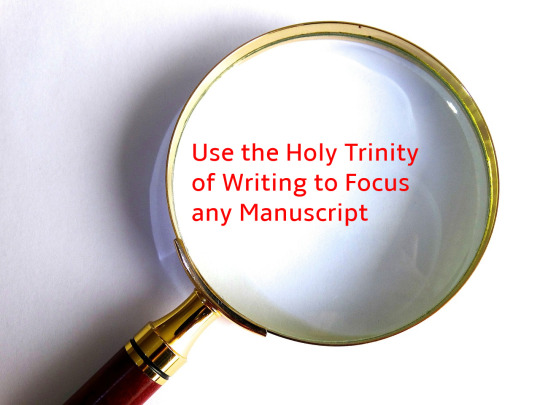
Ever take a look at your story and notice it's wandering here, there, over the river, through the woods, and all the way to grandmother's house?
Whether you are brainstorming, writing, or revising, it can be difficult to discern what belongs in your story and what belongs on the cutting floor--what is a good, appropriate idea, and what is a less-than-good, not-quite-appropriate idea.
Unless you know about the holy trinity of writing. What is the holy trinity of writing, you ask?
Well, nothing . . .
EXCEPT THE THREE KEY ELEMENTS THAT MAKE A STORY EXCELLENT.
(Spoiler: I'm the only one who calls them "the holy trinity of writing," so don't use that term elsewhere unless you want strange looks (which, let's be honest, sometimes makes life more exciting 😉).)
With these three elements, you should--theoretically--be able to evaluate what content belongs in your manuscript and what belongs in the recycle bin (oof, so harsh). Have I always thought of these three elements as the holy trinity of writing?
Definitely not.
In fact, years ago, I would have scratched my head at one of them.
But as I've grown and gained experience, I have found this fact to be largely true:
Everything* in the story must connect back into one of these three components.
*Well, "everything"--you know how writing "rules" are.
Character (arc)
Plot (cause and effect events that make up "what happens")
Theme (what character arc + plot is teaching us about life)
99% of what you write should be touching and progressing one of these things, and often, all three.
Really? Really.
When you have and know all three components of your story, you are able to brainstorm better or evaluate better. You are less likely to wander down roads that lead to hundreds of pages needing to be cut.
Knowing each of these three things will help you refine everything you write. The good news is, you don't have to know everything about each of these topics. (Well, at least not until the end, perhaps (though some writers may even argue against that).)

What You Actually Need to Know About Character
Often newer writers will write scenes that don't actually progress the story. When asked why the scene is there, they may point to the fact that it provides characterization.
But just providing characterization usually isn't enough.
Don't confuse characterization with character.
Characterization is often surface details and, sometimes, irrelevant personality traits. While that has a place, the most important thing about your protagonist is how he or she changes (or . . . doesn't change) and the way they do (or . . . don't . . .).
The character arc (or lack thereof) is the most important part of character when crafting a story.
If you are writing a protagonist that "changes," he or she will start with a misbelief, flaw, or inaccurate worldview that will do more or less a 180 by the end of the story.
If you are writing a protagonist that is "steadfast," he or she will start with a belief, trait, or worldview that will then be tested through the story. In the end, he or she will stay true to that belief/trait/worldview, regardless of the cost. Typically, a steadfast character will grow by degree, not a 180 flip. (Though it is true that some steadfast protagonists may not grow at all.)
As the plot progresses, it will need to illustrate how your character changes or holds steadfast.
Because of this, one of the most critical things to know about your protagonist, is how he is at the beginning of the story vs. how he is at the end of the story, and which belief/trait/worldview is being challenged or called into question.
Even if you do not know how the story ends yet, you should probably have at least an idea of what the character is like in the beginning--which will give you a clue as to what aspect of him is going to be challenged in the story.
If a scene or idea feeds into or illustrates that, then it's a better than one that does not. If a scene does not illustrate that, then its significance may be called into question. However, as long as the scene hits one of the other components, it has a chance of being safe.

What You Actually Need to Know About Plot
Plot is a series of cause and effect events, at least to some degree. Sure, there are exceptions, but almost none.
Once you understand that plot is cause and effect, you'll be able to avoid random, irrelevant events that can make the story convoluted. Every event must somehow connect into another event--even if that is strictly based on how the character arcs or what the theme is saying.
Sometimes you may come up with a great idea for an event--you can use it as long as you can find a way to make it connect significantly. (And what makes something significant is its cause-and-effect potential.)
To put simply, plot isn't just random good ideas. It's events that feed into one another.
To start a story, you at least need a premise.
When Fa Mulan learns her weakened father must go to war to fight the invading Huns, she secretly disguises herself as a man to take his place.
The premise of Mulan already suggests a series of connected events.
Because her father is called to war, Mulan goes in his place.
Now the events in the story must build off that concept. They can build in surprising ways. But they need to somehow connect.
If you know the character arc and the theme, then you can also use those to evaluate what ideas for events will work better than others to focus the story.
For example, if your character needs to completely change by the end, you'll be better off picking events that will provoke that change.
If your character needs to be steadfast, you'll be better off picking events that will challenge their steadfastness--that will make it very costly to remain steadfast.
In each scene, something important needs to change in order for the plot to progress, for the story to move forward. If nothing important changes in the scene, then it probably doesn't need to be in the story.
(One rare exception is if the point of the scene is to illustrate a lack of change.)
Every scene should have a turning point that leads to new decisions, in order to move the plot along.
If it doesn't, it may need to go.

What You Actually Need to Know About Theme
How the events play out and change the character teaches something to the audience (whether or not you want it to). This is the theme.
What do you want your story to say?
It's okay if you do not know right away, but the character arc and the events of the story will often at least suggest a topic for a theme.
Maybe you don't yet know the teaching, but you can at least come up with a topic (or a few).
For example, in Mulan, a theme topic that emerges is gender roles--because she's going to have to pretend to be a man.
Through the course of the story, the theme topic will need to be fairly explored from different perspectives.
So in Mulan, we see various perspectives on gender roles.
When brainstorming, writing, or revising a story, it's helpful to keep in mind what the theme topic is, so that you can pick characters and situations that will explore and question that topic. If you are deciding between content or need help focusing the story, an idea that feeds into the theme will be better than one that does not.
The thematic statement (the overall teaching) will come at the end of the story.
If you are writing about a "change" character, he or she will exemplify the opposite of the thematic statement at the beginning of the story, and change 180 through the events, by the end of the story (typically).
If you are writing about a "steadfast" character, he or she will exemplify the true thematic statement at the beginning (typically)--although his or her understanding of it may need to be refined. This will then be tested and challenged through the events of the story, but in the end, the character holds to the truth.
(There are exceptions to both of these, but I'll save them for another post.)
What happens in the story needs to explore and feed into the theme.

Once you have an idea of what these three things are, everything in the story needs to connect back into them--at least one of them, but often, all three of them.
This means when you know what all three are, you can write a stronger story more intentionally.
And you are less likely to write material that ends up needing to be cut anyway.
Or if you are revising, you can make your story tighter.
All in all, understanding the holy trinity of writing--character, plot, and theme--will help you refine and focus your story into more of a masterpiece.
And if you would like to learn more about this concept in depth, Lisa Cron talks about much of these same ideas in her book Story Genius.
285 notes
·
View notes
Text
Blood of Dragons: Rain Wilds Chronicles Rundown
Mixing up the format a little bit today, but we’ll make it through @sonnetscrewdriver!
Thymara
First lets state the truth: Thymara has changed a lot from the first book.
Thymara has undoubtedly grown and has gone on to make her own rules, her biggest change being she has learned to love and understand herself.
I see that, Hobb has made that clear.
What’s hard about Thymara is that while I’ve come far in appreciating her as a character, in the end I don’t really agree with her views.
Which isn’t like a big deal. It would be if Hobb didn’t express her character’s as well as she does but like most characters in Realm of the Elderlings I understand Thymara.
I get her.
I just don’t agree with her, and I’m not talking about her “choosing” Tats over Rapskal, although the two boys do represent narrative ideas so in a way they are connected - but whatever ignore that for now lol.
Rapskal was being an asshole during his and Thymara’s confrontation right before the dragon’s flight to Chalced. He was angry and hurt and probably scared and was lashing out with words and accusations.
But while he was in the wrong, he wasn’t making stuff up.
“How is that fair? What sort of love did you have for me, that demands that I must always remain the same?” - that’s some real shit right there.
“You still can’t step away and decide things for yourself.” - like DAMN!
This Elderling series was all about changing the rules, changing social structures, just as much as it was about physical changes being tied to our inner personal changes.
I mean, it’s not a ~coincidence~ all the Keepers are adolescents; The Rain Wilds Chronicles is a unveiled (hah!) coming of age story displaying all the insecurity, fear, sexuality, mental tribulation and physical changes one experiences when stepping into adulthood - and when social constructs are restructured anew.
And at the end of the story Thymara is still pretty childish.
Which isn’t inherently bad!
Thymara is just going much slower than others are. She is choosing to go slower and that’s her choice and it’s a choice expressed well within her character arc, her agency is clear.
What I disagree with is Thymara’s belief that her views, her chosen pace, is ‘correct’ (and I’m a little miffed the narrative leans towards supporting her view, which in my opinion dilutes the potency of the CHANGING THE RULES! themes).
Now, Thymara doesn’t express this directly towards others that often and really the only person she seems intent on passing judgement on is Rapskal (well, and Jerd) - and a part of that is because Rapskal puts her in that position, he pulls just as much as he pushes that’s true.
Which is why Tat’s won out in the romance department and that was the right choice for those characters in keeping their characterization honest.
My point is that Thymara has made the correct choice for herself, that’s thoroughly explored, but her continued unease about whatever everyone else is doing and how they are changing (especially Rapskal) is telling.
And as a third independent thinking party Thymara comes off as a bit pious to me.
I feel in my bones if we ever come across her again we may see her look back on her early steps into adulthood with embarrassment.
Thymara is going to come out of her adolescence a lot safer, a lot sturdier then others due to her slow pace but not necessarily more emotionally or mentally secure.
Her risks remain low, Thymara only starts to actively engage her own life at the end of the tale.
But what was her last moment in the series? She flew! However briefly.
I believe Thymara’s wings are representative of the idea that she is going to continue growing, that eventually she’ll be higher than everyone and when she rises her perspective will drastically shift.
Because time is it’s own change; aging is it’s own change; incorporating experience into your life is it’s own change; and Thymara has taken the tortoise route.
Then there is this guy:
Rapskal
Rapskal is in the opposite direction of Thymara with his own terrifying adolescence pitfalls.
Rapskal believes that because he has absorbed memories of older people (in passage of time and age) he thus has experience - and that’s somewhat true!
Reyn confirms this when he is shocked that Rapskal can beat him in swordplay. Rapskal’s body absorbs and remembers Tellator as much as his mind; he is built mentally different than the other Elderlings and he is stronger both in body and conviction.
The rub is that Rapskal uses memory stones as shorthand for his own existence, uses them to bypass his own early stage adulthood and skip to being someone new entirely.
He’s already committed to his new perspective, he has already flown whereas Thymara is only starting to believe that maybe someday she can.
But he is still someone of his own making, incorporated memories and all!
Rapskal has made choices just as much as Thymara has. Neither of them are wrong in their choice because the point is that the choices belong to them individually, the issue is that they can’t see it that way yet.
Because that’s growing up; can't see the forest for the trees.
And sometimes people get lost and/or grow apart.
Thymara shouldn’t have sat around and sulked and felt sad about how SHE was loosing her friend Rapskal - she thought of him only as how he related to herself and what she wanted him to be.
Rapskal shouldn’t have pressured Thymara into treating the memories she absorbed as he was treating the ones he did, he made the same adolescent mistake when it comes to growing up in close proximity with others - he too considered her as how she related to himself and what he wanted her to be to him.
Basically Thymara and Rapskal are seriously convincing teenage protagonists! LOL
Those teenage years are full of selfishness, confusing, draining, terrifying, selfishness. They are! That’s what’s so hard about them, you don’t see it until you’re past it, until you’re above it.
And I think that’s the deal with Elderling’s coming from Humanity.
Check it:
Plot/Narrative/Setting
We know now that Elderlings come from humans; so in a lot of ways we can view humanity as an adolescent stage.
Kelsingra itself is like the adult form of Trehaug; traveling up river the water starts to run clear and the ground begins to firm.
Growing up is hard, the physical changes take getting use to; the solid ground feels odd compared to the swinging imbalance of the last place.
Humanity is changing to survive and learning to coexist with dragons once again; the growing pains of which is it’s own social, ideological, adolescence.
I think you get my point!
No one knows exactly what they’re doing. Everyone is just making Elderling society up as they go for the most part - the beautiful self discovery and terrifying responsibility of adulthood transferred onto an entirely new race and society.
It’s a little frustrating we won’t get to directly see the Elderling’s ascend but they’re now far too big a presence in the narrative space to not come back to, possibly even sooner than later! I’m excited to see what Fiz and The Fool has to offer me and what kind of thematic extension it may be to the end of Rain Wilds.
Because this last book feels like another set up, doesn’t it?just a little bit? It feels like Blood of Dragons is leaning into another book - but that could just be the anticlimactic tone lol.
I’m super excited to go back to Fiz and see how he’s doing and what nonsense he’ll be sucked into next but, again, it’s frustrating I won’t get to experience the keeper’s owning their choices and owning adulthood - as with Thymara I’m really pressed to see how time and age will change their views of their journey up the river and into Elderings. I don’t want to wait! Haha, silly.
Something that was disappointing with the end of this book is that because the cast is so large it doesn't feel like a lot of people get any kind of closure for the reader, you know?
Tats and Thymara getting the last scene made me a little worried, like maybe I misunderstood the series? I worried that maybe their relationship meant more to the narrative then I had picked up on simply because it was given the weighty place of being the last scene, whereas many loose threads among the many other characters were left dangling.
So that was a bit unsatisfying.
But all in all most everyone got their grand (to little) moments of confirmation in who they’ve become.
Not my favorite book in the series but still a solid entry!
AND MY BABIES LIVED! Yaaayayyaayayaaaaaaaaaa *gurgle*
Alise
Alise is off and rolling! I hope she gets the recognition she deserves for her scholarly work and I hope she continues to pursue it, just as I hope she continues to pursue her new life.
I appreciated how quickly Alise found happiness, found what she wanted, and didn’t torture herself with denying herself that happiness (unlike some Six Duchies men I know...)
Alise and Leftrin’s bond is secure and I really liked how the confrontation with Hest was at no point played for will-she-won’t-she-drama, we knew she had no remote desire to return to hest, no hesitation to cast him aside to his face.
Alise’s total and instant shutdown of Hest was hard won on her part and I liked how it wasn’t treated in the narrative like this glorified shiny moment but rather a resented necessity.
Captain Leftrin
The sweetest and most stoic man, partner to my favorite Liveship.
Just a treat. <3
Sedric
Good job Sedric! Well done!
Sedric has come a long way and still has further to go.
His struggle with trying to untangle himself from what Hest shaped him into and then what of that shape he genuinely enjoys or wants to discard is interesting stuff that I wish we could have dug into a little deeper - another draw back of having such a huge cast.
Overall we leave Sedric in a good place, I get the feeling he’ll settle into a place of some importance in new Elderling society and I hope his organization and communication skills are put to good use, for his and other’s benefit.
Precious man.
Tats
So I’m sitting here, trying to think of what to write about for Tats and the first thing I did was think, “Well, why did Thymara want?”
Why am I thinking about Thymara when I’m trying to talk about Tats?!
That’s what’s so frustrating to me about this character!
I. Don’t. Know. Him.
I don’t want to say Tats is boring but Tats is borning.
He is nice.
He is patient.
That’s it?
I’m indifferent to Tats and Thymara ending up together. I’m not invested in their relationship and never was, nor was I ever really sold on the non-love-triangle stuff.
And that’s why the ending of the series felt like maybe I missed something? LOL
Like, I was sitting there going “Wait, really? We’re ending on this note with these two? Oh shit I didn’t invest right.”
It was a weird realization! I also realized I didn’t care lol
I think I still got plenty out of the series and understood the wider themes just fine even if the specific route of Thymara/Tats eluded me.
Highlighted Passages
She could change. She wasn’t chained to her past. She could become someone who wasn’t merely a product of what others had done to her. It wasn’t too late.
Isn’t it what humans have done for generations? We claim the land as ours and turn it to our purposes. We change the channels of rivers and the face of the land so that we can travel by boat or grow a crop or graze cattle. And we think it only natural that we should shape the whole world to be comfortable and yielding for humankind. Why should dragons be any different in how they perceive the world?
From Ronica Vestrit of the Vestrit Traders, Bingtown To Whatever Incompetent Bird Handler is accepting messages in Cassarick
Humans could never accept the world as it was and live in it. They were always breaking it and living among the shattered pieces.
She’d had to change her image of herself from the very bones out. Ultimately, she knew, it had been good for her. That did not mean she enjoyed being reminded of it.
When she ventured into her memory sampling, it was for a specific purpose and she kept her attention tightly focused on what she wanted to know, refusing all other tugs at her attention. It was like diving into deep cold water to retrieve a sparkling stone.
It was Tarman’s way, and for himself, Leftrin was grateful that his liveship was more taciturn than most. He did not think he could have enjoyed a chatterbox like the Ophelia or a moody and dramatic ship like the Paragon. But there, it was probably like it was for children. Each parent thought his was the best, and doubtless every captain would prefer his own liveship to any other.
She tried to see him impartially; was he an ugly child, doomed to be rejected by other children as he grew? She had found she could not tell. He was Ephron, her little boy, and his differences were part of who he was, not points to be compared with others.
King and queen. It made her ridiculously sad. The dreams of Malta the girl might come true even as the longings of Phron’s mother were destroyed.
He blurted out the words and then was horrified. He had never intended to speak of it to anyone. Having someone else know about it made it real.
“There is something about knowing that someone is taking pleasure in giving you incredible pain . . . with no remorse. It changes how you see yourself; it changes what you can believe of other people. It changes everything.”
Elderlings found a way, but I do not recall the details of it. They could touch it and wear it on their hands to work their magic. It gave intent to stone, and it spoke to wood and pottery and metal, bidding it be a certain shape or react in a given way. And those things did as the Elderlings bade them. They made doorways from it, entries of stone that they used to travel to their other cities. They created buildings that stayed warm in the winter. They made roads that always remembered they were roads and did not allow plants to break them. The most powerful of them sometimes used Silver to transform themselves at death, going into the statues they made to preserve a strange sort of life for themselves.
And ridiculous red Heeby flew wherever she would, now part of the formation, now trailing it, now flying to one side. Her slender scarlet rider sang as they flew, a song of anger and vengeance, but also one that praised the beauty of angry dragons in flight and painted a glorious victory for them. Ridiculous, and ridiculous that she and the others enjoyed it so. Thymara had complained more than once about how freely the dragons used their glamour to compel their keepers to tend them. Yet not once had she ever admitted the power that human flattery and praise in song could exert over dragons. She was not the only dragon who flew with her mind full of Rapskal’s glorious images of exotically beautiful dragons triumphing over every obstacle.
But Sedric, what have you done? All will know that you . . .”
“That I am what I am,” he said calmly. “I do not apologize for that. Ever.”
“I knew Hest existed. I knew you’d been his. There were times when I felt like a thief. There was a day when Sedric took me on about it, saying that I was going to ruin your whole life by loving you. Made me feel selfish and low for wanting you.”
“It seems a lifetime ago.” She smiled at him. “We used to worry about such peculiar things.”
“He made no cry for vengeance when I was the one who was dying,” she observed sourly to her Elderling. “Yet let them succeed in giving him a bellyache, and he will melt all their cities with venom.”
Malta was not pleased to let him go and not only because she feared for him. No, she had wanted to be the one to ride the queen into battle.
He and Carson and Malta had had several long and philosophical conversations about how these new Elderlings might form their society. This was his first unveiled look at it, and he tried to conceal his surprise and dismay.
Distantly he heard Davvie shouting something about “you torn-up old umbrella!”
“You’ve seen many things in the stone, haven’t you, Tellator?” He looked at her consideringly.
“I lived many things,” he replied. “And other things I know from the stone ancestors I chose for myself. If one is to be a warrior, then one chooses the accounts of warriors, to read them from the stone and to use their experience again. And so I am Tellator, but I am also the ones that Tellator incorporated into himself.”
Brashen scratched his chin and then smiled at Althea. “Changing history seems to run in your family. First Wintrow and Malta, now Selden.” He took a sip of his tea.
Paragon spoke up, his voice wry. “So fortunate for you that you married the sane, responsible female in the family.”
Brashen choked.
We begin a new time. Perhaps we begin with new ways.
1 note
·
View note
Text
SnK 89 Thoughts
“Someone once asked me if I had learned anything from it all. So let me tell you what I learned. I learned... everyone dies alone.
But if you meant something to someone... if you helped someone... or loved someone... If even a single person remembers you... then maybe you never really die.
And maybe this isn’t the end at all.”
The above is a quote from the fifth and final season of Person of Interest. If you haven’t seen it, don’t worry; I’m about to quote something else that maybe five people will recognize. Also it doesn’t matter much. I just ran into a snag with coming up with how to start this post, so I went with the old-fashioned method of taking someone else’s words.
For the other quote, I have something not nearly as long or haunted.
“I will remember those who have been forgotten.”
--The Stormlight Archive
Throughout the series, one of the recurring plot threads that I’ve been perfectly happy to ignore is the one that touches on the subject of memory.
Humanity has no memory of life beyond the walls.
Titan transformations interfere with memory.
Grisha tells Eren to learn to use his powers from the memories of others.
Frieda regularly wipes Historia’s memory.
Eren and Historia both have dreams of incidents that their waking selves can’t remember.
The cavern built by the Founding Titan, combined with the touch of royal blood, allows for the recovery of memories.
To an unknown extent, nomming a Titan can transfer their memories to the power’s recipient.
Memory has had a part to play since the very first volume. Most prominently in its absence. There’s enough amnesia going around in the series to get a soap opera up and running. Haunting every step our heroes take has been the knowledge that someone has the answers to this world, and they’re out of reach.
First, it was the basement. Grisha.
For a little while, Ymir, as one of the few big friendly giants they knew.
Next came the Reisses, with the introduction of the Founding Titan.
Eren slipped into that same arc, holding the Founding Titan but unable to access large swathes of its capabilities because he doesn’t have the blood for it.
As a metaphor, it’s already pretty nifty, but the literal truth of the situation is that the people who can provide the most help are dead, but never truly forgotten. They are remembered.
Grisha remembers his sister. He remembers Eren Kruger. He remembers Dina. He remembers Zeke. He remembers a world the common citizens of Paradis have never known. He does everything he can to pass on that knowledge.
The Reiss family sacrifice one member every thirteen years to keep the Founding Titan’s memories alive within their house. In turn, the Founding Titan remembers its hosts, keeping them alive for whoever comes next.
The Survey Corps doesn’t have magic Titan powers as a tradition, but they follow the same principle, as put forth by Erwin before his dying charge:
“Those brave fallen men and women! Those poor fallen men and women! The only ones who can remember them... are us, the living!! So we will die here... and trust the meaning of our lives to the next generation!
That is the sole way... we can rebel against this cruel world!”
And before any of that, there is Mikasa.
“If I die now... I won’t even be able... to remember you.”
People finding their reason to keep fighting has always drawn fiction’s attention. Angst calls to a lot of writers, as well as readers, and loss is such a universal concept that of course it’s going to be covered in all its gory detail long after everyone is sick of death.
When Mikasa loses Eren in Trost, you can see the light go out. You don’t really believe she’s going to die, since hey, we’re a protagonist down and she just got a flashback, but everything we know about her says that this feels like an insurmountable loss. She has Armin, but in her head, all she knows is that her family’s gone. Again.
It’s a tragic sequence in either medium you go with. I’m partial to the anime, because I love the music cues in that scene.
Then, as the story requires, she finds her way back to her feet.
Everyone remembers the line about the world’s beauty and cruelty, as well they should. It’s a beautiful line, thematically perfect, and come to think of it, Mikasa should probably get a medal for how well she introduces the prominent themes of this work.
When she makes the decision to live, however, it’s rooted in Eren’s memory.
That always felt a little weird to me, so it’s more memorable than it already was. She continues with lines about fighting, and winning (I think I said this last month, but just because Mikasa was only following Eren to the Scouts doesn’t mean she doesn’t belong there as much as any of the other chaotic dreamers), but the sticking point is wanting to remember Eren.
He’s dead.
His memory shouldn’t be.
This is the scene in the anime that forever sold me on the series. Back then, that particular line was more of an odd fascination than anything else, a touch of uneven humanity buried under the other phenomenal moments--Mikasa missing Eren, but loving him too much to let go of everything he is to her.
Just like their first meeting, Eren keeps her alive long enough for her to find herself, and what she’s willing to fight for.
So we have this incredible scene, and volumes and volumes later, it’s only now that I fully appreciate how tightly woven together all of the important moments are.
When you think about it for a fraction of a second, everyone is constantly dying in this series. Often not people we care about, but there’s a lot of death.
With so much of it, it makes sense that the memories of people they hold dear have so much power. They’ve learned to make the most of life, and that includes the pieces that come after death.
That’s the romantic view of it that really has nothing to do with Titan powers.
Now, on the subject of Titan powers, Eren’s managed to fall through one barrier of being an incomplete Founding Titan holder; he can relive the memories of stories he’s already familiar with.
That... is far from where we want the kiddo to be.
Before this extended flashback sequence with Grisha and Kruger, Eren’s memory troubles were primarily devoted to his father murdering an entire family, being eaten, the injection that was the focus of both those things--and a random shot of Frieda brushing her hair.
It’s difficult to tell how much of that flash to Frieda is a narrative cheat. He doesn’t remember it afterward. It does come after Historia recites her sad backstory to the class, but Historia doesn’t remember her sister at the time. Eren could be having headaches and leaving out all sorts of people, but we’re only going to see the relevant ones.
Still, Frieda’s the only one of the bunch that Eren doesn’t have a clear link to, and she shows up during a time where everyone is discussing the significance of the Reiss family.
That would seem to imply that the memories of the world that Eren is carrying around respond to outside stimulus. Which I guess we already knew because of the cavern and the touching, but there, we were given specific, mystical reasons. This seems more down to earth.
Making it less helpful, naturally. It’s not like they can go to Marley and kick off yet another kidnapping arc, only with them as the kidnappers, and hope someone says something that unlocks another chapter of Eren’s memory books.
Which would be why royalty’s back in play in the main plot. One day I might get to that portion of the post.
Getting back to the pages that spawned all of these words no one cares about, to the surprise of me, Kruger’s last words to Grisha are some of the most interesting in the chapter.
Kruger and Grisha have no idea who Mikasa and Armin are. Kruger is unconcerned, having been dealing with magic in his head for quite some time. He assumes that they’re the carry-overs from someone else’s memories.
This is where, if you wanted to, you can make it really convoluted.
Hiiii.
Reincarnation has been a fun theory ‘round these parts for a while, with the taunt of Ymir’s name only inspiring more detailed versions.
We now know that even if Ymir is Ymir’s reincarnation, no one actually believes that to be true--anymore.
Someone was still willing to present her as such, and believed in her enough to feel betrayed when he believed himself to be wrong, so it’s fair to say that some number of Eldians are willing to believe in their god being reincarnated. All things considered, that doesn’t really mean anything, because this manga is willing to let people believe all sorts of things.
But in the same chapter, we have a bitter old guy telling his predecessor that they’re doomed to repeat a horrible history again and again, and thinks of Mikasa and Armin’s existence as a memory, not a premonition.
So like. If you wanted to, a case could be made for and EMA reincarnation trio getting consistently roped into this, sometimes accompanied by Ymir.
A safer bet is probably just that super special awesome Titans have premonitions in addition to remembering everyone who ever was, and assume that those premonitions are things that have already happened, not things that will again.
Honestly, this is something that doesn’t interest me that much. I’m positive that this has something to do with why Eren sees an older Mikasa in his dream as a child, but what it means is still up in the air.
The straightest line through the plot is that Kruger is seeing through Grisha’s eyes before he gives Grisha the serum, seeing what Grisha will say when he passes it on to the next Eren. Supporting that is that this Eren has no clue who Mikasa and Armin are, but Grisha certainly does at a later point.
Future vision is always the simplest answer.
But like I said, if you want to bring the reincarnation madness--you have a very clear invitation.
Anyhow, as uninterested as I am in... large portions of that, the part right before Kruger brings up cycles of suffering is what I like.
“Make a family. You need a full household once you enter the walls. [...] Your wife. Your child. Even someone on the street. It does not matter. Love someone inside the walls.
If you can’t, we’re doomed to repeat it all again. The same history. The same mistakes. Again and again.”
At first it sounds like Kruger’s telling Grisha to run off and get hitched and make babies, but the rest of the discussion makes the blood component secondary. It isn’t a matter of making children; it’s a matter of family.
Make a family.
Love them.
That’s the way out.
Grisha finds Carla and has Eren, but he also has Mikasa.
Eren and Mikasa have Armin.
The three of them have the 104th.
The 104th has the Survey Corps.
If you look at what happens to the mainland Eldians at the time of Grisha’s transformation, you can see the difference. Kruger watches dozens of his people die, participating in their deaths and torture for the greater good. Grisha loves his wife, but sees his child as a tool.
Love doesn’t bind these people together. A shared cause, sometimes, but Kruger doesn’t watch Grisha lose everything and hug him, or help him through it. They’re callous and straightforward.
I don’t know if Kruger is being literal or figurative about the cycle their world is stuck in, but the Survey Corps has started a broken kind of family. Somewhere inside all of the hard choices and death, there is love. There is a group of people who will fight for each other.
With the politics involved, I’m sure nothing can be that simple, but their hearts are all in the right place. They aren’t so consumed by their cause that they’ve close themselves off to everyone. A good portion of them still cry over killing traitors.
It seems safe to assume that Grisha has not designed the perfect battle plan, but he loved Eren, and Carla, and Mikasa, and whatever cruelties followed, that love has done them a lot of good.
It could turn out to be more significant than that, or it might not. We shall see.
Though know that if it turns out that the main plot truly is reincarnation madness + time loop that can only be stopped through the Power of Love...
...
I’m... not actually sure I could be upset if that happens. It sounds amazing.
Basic point: A family can be an Eren, Armin, and a Mikasa.
Moving on to something besides the last three pages now, we scurry back to Mikasa and Eren getting special treatment because they make up a fifth of an entire military branch.
There isn’t much to say on that topic; keeping the kids disciplined is good, but everyone involved knew that the punishment wouldn’t convince them out of fighting for Armin, so they might as well move on and do something productive.
Levi and Hange bickering is life, though.
Even if they’re temporarily going with the, “We’ll just let our main weapon be crazy and call it puberty,” line. I don’t think either of them believe it, and everyone’s going to have to sit down and have the memory discussion at some point (wherein Eren will realize that he fails at lying), but for right now, I think Eren’s potential lack of stability is a discussion for a less hectic day.
Drifting back over to horrible things, Mikasa is... doing about as well as one might expect during this phase of the “My family is all going to die again,” arc.
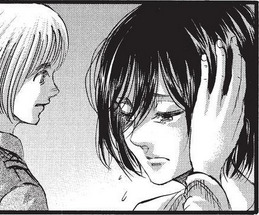
Mikasa’s tell when it comes to family worries is always holding her head in that way. It happens after Carla’s death, and it happens after Reiner and Bertolt successfully steal away Eren.
Armin and Eren are--okay, Eren’s probably right for once about emotions. I don’t think things have fully sunk in for them. Mikasa, though, is living out her worst fear again. Trapped in a cell by herself, she only has herself. She can make do with that, but she never wants to, and she certainly doesn’t want to be forced into it by losing the people she loves.
Whenever Isayama decides to make Mikasa the focal point of an arc (I refuse to believe it won’t happen), things are going to be rough.
Other horrible things include the entire world not being a safe place for Eldians. No one wants people who can turn into giant monsters around unless they can be useful, and even then it’s a stretch.
So we’ve gone from our heroes being locked inside a series of walls, surrounded by monsters, to those monsters turning out to be their own people, to their own people often being monsters, to other people, but still humans, definitely being monsters, and really, it’s a much worse monster problem than anyone had planned for so what do.
Presumably, it’s things like this that led to the First King locking everyone up in the first place.
The nice thing about this flashback sequence is that we have one very simple solution for the Reiss/Fritz situation: The King likely changed his name.
Now, whether that’s actually true or not remains to be seen, but for the time being, everyone’s running with there being one royal blood line, and it not being at all weird that it’s now the Reiss line, not the Fritz. And considering new plot developments, there’s probably not much reason to look accusingly at the situation any longer.
Royalty is royalty by whatever names they dream up for themselves. That’s the story.
I think the most interesting piece of the flashback is that the First King made a vow with the Founding Titan. Somehow, he managed to communicate with his own Titan, and forge a psychic promise that has lasted over a hundred years.
Does that mean that Titans are sentient inside their hosts?
Is that what Armin sees in his dream?
How much can they control the hosts without explicit requests or permission?
I’ve gotta say, even though his Xtreme Pacifism w/ brainwashing is obviously not something a person should be doing, and obviously disagrees with the theme of fighting to win, everything we hear about the First King makes me want another flashback arc.
Not right now. Geez, no.
But one obviously needs to happen.
It was funny enough when he dragged a bunch of his people to an island, locked them inside, told everyone outside they couldn’t have his toys or he’d set his colossal army on them and they’d all die.
Now it has the companion piece of him saying that maybe they all deserve to die if they can’t stop fighting for five seconds.
This person is clearly related to Historia.
From the outside, he’s obviously made some very sketchy, probably not altogether helpful moves, and played with the lives of people in ways he had no right to.
From a character perspective, this is a person who actually had enough conviction to break all tradition, kill anyone who could remember that tradition, set up a contingency plan for which the word “overkill” is perhaps designed, and did it all because he thought that everyone deserved to die if they abused their power--oh, and he also put in a safeguard so that for over a hundred years, all of his successors would find it impossible to color outside his lines.
No other character or group in this manga has been so ruthlessly effective. You can even scrap the ruthless part. This is an individual who used his hammer, made everyone else a nail, and called it a day.
While being scornfully judgmental.
In a peace-out kinda way.
This is where the story gets even more interesting.
The world is going to want our guys dead. They’re too dangerous to keep alive, and having Titans without the Founding one isn’t the prestige boost it once was.
The Founding Titan is the best protection they have against extermination.
Eren makes the leap fandom’s been making for months. The last time he made the power work, it was while he was touching a titan of royal blood (hey look, a reason for Kruger not to give the Attack Titan to Dina!). That might be how to trigger it.
There’s only one person left in that line.
She wouldn’t eat you, Eren.
This is about touch, but the positions are still neatly reversed. Eren’s making the same choice she does--for slightly less selfish reasons. The question is if everyone else can be okay with that, and whether or not Eren will be able to justify putting humanity at risk to keep his friend.
Or maybe he’s wrong about his guess, and he’ll just end up swooping around the woods with Historia on his back. She’s short, she could totally be a Yoda.
Mikasa, Armin, and Hange clearly know something’s up. Really, it’s all about how far they’re willing to push. Can they kill the Queen to save their people? Is it even necessary? Outside of necessity, is is an action they’d be willing to participate in?
We’ll probably find out!
Though Armin’s attention in particular makes me slightly antsy.
“I haven’t lived an especially long life... but there’s one thing I’m sure of. The people capable of changing things... are the ones... who can... throw away everything dear to them. When forced to face down monsters... they can even leave behind their own humanity. Someone who can’t throw anything away... will never be able to change anything.”
Hi, Armin from Chapter 27! Please don’t foreshadow unpleasant things!
Many things in the direction this story takes are unknown. We don’t know for sure what kind of ending we’re getting, or which message will prevail in the end.
Personally, I’m an optimist. Armin talks about throwing things away in the seventh volume. Way too many paragraphs in this post talk about how people have survived by doing the exact opposite.
I want to believe that if it turns into a battle of ideals, being better than the monsters will prevail. Forming families and loving them.
But boy howdy is this an uncomfortable playing ground to feature that in.
And that’s it from me.
Time to wait impatiently for the next month.
.
.
.
.
Oh yeah, Historia read Ymir’s letter.
I suppose I’m supposed to say something about that.
Right.
HOW THE HELL CAN ALL OF THIS FANFIC NONSENSE EXIST IN THE SPACE OF SO FEW PAGES.
Do you have any idea how long it took me to realize that this latest instance of Ymir being an overly dramatic idiot is actually canon? Sure, she jumps off towers into hoards of monsters, and makes up lies in the middle of kidnapping her girlfriend, but I’m choosing to believe that the translation is accurate in representing Ymir’s writing style of horrific floweriness to play off how sincere she’s about to be.
ALSO: “I am about to wow you with a romantic tale.
It starts with me starving to death and ends with me getting stoned.”
THAT IS THEIR RELATIONSHIP. STOP POINTING OUT REASONS WHY REINER DOESN’T HAVE A GIRLFRIEND AND START WONDERING HOW THE HELL YOU HAVE ONE.
I’m mostly sure that this was done the way it was so that Isayama wouldn’t have to deal with too much Ymir speculation in the wake of revealing the ancient Ymir. The fact remains that Ymir plays up her tragic tale of woe as a love letter, and this is like a good third of why Historia has trust issues.
More seriously, this ties in to what the rest of the chapter wasn’t about, but I made it about: Memories.
Ymir believes she’s about to be very dead (we all have future vision now). She can pick what she tells Historia. She chooses her life. She chooses to tell the girl she loves, the girl she finally got to be herself with, all of the pieces that came before them. She tells her what she was. She glosses over all of the whys, and just tells Historia what she experienced.
She tells Historia the full truth about how they’re alike.
She tells her about her suffering.
She’s willing to admit that she finds the world incredible. All of her cynicism about what happened to her and how little it matters melts away, and all that’s left is freedom, and a life that she doesn’t regret.
Except for the part where they aren’t married.
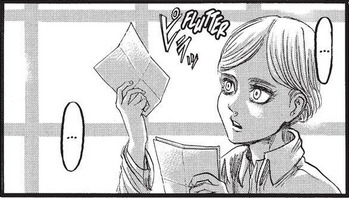
You do not understand how much I enjoy Historia’s reactions to things.
Ymir gives Historia her whole history to remember her with, not just the parts they shared. She calls it a love letter, and brings up marriage so abruptly that no wonder Historia is confused, and while those are true expressions of how she feels, the romantic part of it is that Ymir wants Historia to know her. She wants to apologize, and let Historia know that them being incomplete is her only regret--and she wants Historia to know her before she’s gone. Even after she’s gone.
Historia’s the person she loves, and the person she wants to be with. She can’t be with her, but she can be remembered by her.
Yeah, that’s such romantic way to be SO UNBELIEVABLY UNHELPFUL.
Historia’s reaction is really the only correct one.
“You play it off the moment you feel embarrassed. How am I supposed to understand like this...?”
HOW ARE YOU BOTH SO BAD AT THIS.
Ymir, protip: stop bringing up marriage only when Historia is on the brink of tears.
Historia: SHE LIKES YOU.
I’ll admit to being dedicated to my belief that Historia does not have the first damn clue what Ymir wants from her, and this sequence really only makes that dedication stronger.
Historia probably understands Ymir better than anyone else on the face of the planet, but she doesn’t understand herself, and as a consequence, I don’t think she really gets how she and Ymir work, except that they do.
In the days before Ymir’s departure, Historia is still perfectly willing to believe that Ymir is only hanging about because of her family, but in the days after Ymir’s departure, Historia tells Connie in no uncertain terms that she knows Ymir. In the immediate aftermath of Utgard, she tells Hange that she knows her well.
Historia really does know Ymir--well enough to claim it as Krista, as Kristoria, and Historia.
That’s different from having faith in someone’s affection for you, and that’s where a lot of Historia’s confusion in their relationship comes from. On the one hand, she knows Ymir, and knows that she’s someone Ymir chooses to hang out with.
On the other hand, no one’s ever wanted her.
Ymir makes it more difficult by skating around her feelings so well that even when her glib remarks are serious, it’s hard to take them that way. She places implications of romance on either side of a story that’s clearly hard for her to let out. It can be read as lightening a heavy mood, or just the truth, and Historia is so terribad at trusting in a relationship that it’s like handing her a toddler’s slot toy and telling her the sdklj goes in the sdklj hole.
YOU’RE BOTH SIMPLE IDIOTS. STOP PRETENDING YOU’RE NOT.
I mean, that’s one facet of her response.
The other one connects to something a little further back.
“Ymir saw the real me… the me that chose the Survey Corps. The me that even I didn’t know about. But… after Ymir disappeared, I stopped understanding who I am… and what I want.”
--Historia, 54
Ymir is still gone.
Historia has learned to understand pieces of herself, and she can be her own person, but the truth is that she only really feels secure in herself when she has Ymir, and Ymir isn’t here. Ymir might never be here again.
Ymir gives Historia her memories.
She doesn’t tell Historia who she was in them.
Ymir’s the only person who has ever had the ability to remember Historia Reiss correctly, and if she’s gone, and she never explains it, how is Historia supposed to know who that is? How’s she supposed to be the value the person she loves sees in her if she can’t recognize it?
These two have no idea what they’re doing.
They never really have, but they always knew that if they were together, somehow, that worked.
Now they aren’t.
The result is that we have the second time in the series that Historia’s tears actually fall. She tears up plenty, but the tears only make it past her eyes twice.
The first time is when he father hugs her, and tells her she’s wanted.
This is the second time, and it’s both cheeks, not just one.
Neither shot provides a clear view of her eyes.
That, obviously, is reserved for when Ymir and Historia are reunited.
(Let me have my dreams.)
Alright, having long since passed the point at which people will give up and go read something else, I... think that might actually be it.
Let the waiting commence.
#Shingeki no Kyojin#SnK 89#Mikasa Ackerman#Historia Reiss#yumikuri#shingeki no spoilers#SnK spoilers#spoilers#tl;dr#chapter post
227 notes
·
View notes
Link
The second season of The Handmaid’s Tale was, in almost every way, a marked improvement on the first. It was bolder in its storytelling, more incisive with its character arcs, and knitted together with stronger thematic underpinnings.
Without Margaret Atwood’s book to fall back on, for the most part, the series pulled back just a bit (literally, in the case of the camera, which dropped more often into wide shots) to examine the ways totalitarian societies hollow from the inside out, taking and taking and taking, until they become the only way of life you know. It was as timely as season one, but in a very different way, less triumphal and certain of the power wielded by large groups of people raising their voices as one.
It was also so, so, so much harder to watch, in a way that maybe sort of broke the show.
This is the paradox of series like The Handmaid’s Tale. Sometimes, making your show better can simultaneously make it worse, can expose the flaws in the template that were always there that viewers were better able to overlook when there were more obvious and glaring flaws to point to.
Make no mistake: The second season of The Handmaid’s Tale will be very high up on my year-end “best of TV” list, and I feel it made only very minor mistakes. (Mistakes that, sadly, include the very last scene of the season, leaving a bad taste in the mouth.)
But I’m more worried than ever — and I was already pretty worried — that the series has no long-term plan beyond rubbing viewers’ noses in misery. And worse, even if it does have a plan to alleviate the sorrow, embarking on such a plan might be antithetical to the spirit of the show, breaking it even more.
Well, unless you’re Fred Waterford. Hulu
The first two seasons of The Handmaid’s Tale form a loose diptych, mirroring and subverting each other in fascinating ways. They’re about survival in the midst of dystopia, about the idea that those who are oppressed continue to find ways to live and hope, even when doing so seems pointless. My guess — more of my hope, really — is that by the end of the show’s run, we will realize this was a “first chapter,” of sorts, as the show pivots to a new chapter about how unsustainable the theocratic hellscape of Gilead is.
But the first season kept stepping back to remind viewers, “Hey, this is a TV show.” Pop songs would turn up on the soundtrack with weird regularity. Handmaids would stride toward the camera in formation, in ways that seemed designed to underline their force as a potential army against their oppressors. It was laced through with hope and triumphalism, with a sense that the series was always about five seconds away from having star Elisabeth Moss flex her bicep in a Rosie the Riveter pose.
This stuff was easy to point to as a problem with the series. After all, the world the Handmaids live in is one that offers little hope or triumph for them. They’re held as rape slaves by a theocratic patriarchy, and even if they theoretically outnumber their oppressors, they’re systemically kept down by a government that believes them to be little more than chattel.
But the more season two wore on, the more it stripped away the hope and the triumphalism, the more I realized that these flaws were part of why the show was able to break out in its first season. It’s similar to the way that Mad Men’s first season was riddled with lots of ridiculous reminders of how different the ’60s were, which critics could point to as flaws, but viewers could welcome as punctures in the show’s immersive nature.
It’s really easy to get lost in Handmaid’s Tale, which is sumptuously designed and filmed at every level. It all but invites you into its space, through those frequent, eerie close-ups, shot with wide-angle lenses to blur out the backgrounds. Hearing pop music deployed as a clumsy metaphor for not losing hope is a great way to break the spell, to lure the viewer back to reality, where things are not this bad. Not yet.
And in season one, early in the Donald Trump administration, it was easy for progressives watching The Handmaid’s Tale to believe that hope and triumphalism could exist side by side with worry and sadness. In season two, that was harder to believe, as it became clear that the actions of Trump, even if he is booted from office before 2025, even if he’s booted from office tomorrow, won’t take years or even decades to overturn, but likely generations. The few times hope punctured the Handmaid’s Tale bubble — one time featuring Oprah Winfrey herself — felt more like dispatches from another universe than ever before.
And The Handmaid’s Tale kept accidentally releasing episodes that directly seemed to comment on what the administration had done just that week, including an episode about Gilead’s squabbles with Canada (in the wake of Trump’s lambasting of Canadian leader Justin Trudeau) and then another in which June’s daughter, Hannah, is ripped from her arms, which aired almost directly in the midst of the family separation crisis at the US’s southern border.
None of this is the show’s fault, of course, nor is the frequently clumsy marketing surrounding products meant to tie into it. But they all increase the noise around the show, which can make it harder to see the series for whatever it still is. (This, again, is reminiscent of what happened to Mad Men.)
And what the show has become is, in essence, a horror series. All of the hope in season one has been ground out of the show. Its shift from close-ups to wide shots in many episodes underlines the ways all of these characters are at once trapped by Gilead and a part of it, unable to escape their own complicity.
The show weaponizes what we know to be true about television — there will always be a status quo for the characters to return to, most regular characters have “plot armor” that keeps them safe — and it uses it to remind us, over and over again, that if you had to live through these truths, unable to change or evolve, it would be an unending horror.
And in that sense, perhaps, it has become a kind of progressive Walking Dead. That show crystallized conservative fears about America under Obama by depicting small communities of stalwart traditionalists being beset by hordes of outsiders.
But where The Walking Dead could always fall back on metaphor — I might be a progressive, but I love zombie movies and can enjoy them purely on the level of genre — The Handmaid’s Tale can’t. It keeps trying to make Gilead a metaphor for reality in a way that would crystallize progressives’ fears about Trump while allowing just enough remove to keep watching. But reality keeps refusing to be made metaphorical.
June goes on the run. Hulu
The final moments of season two of The Handmaid’s Tale don’t seem to radically shift the series’ status quo. Indeed, they seem to underline just how hard it will be for the series to run indefinitely with that status quo in place. Sooner, rather than later, and maybe even right now, that status quo will become untenable.
But the more I thought about those final moments, the more I came to realize that they really do change the show’s status quo considerably, should the series follow through on it. Up until those final moments, the resistance to Gilead within the series was mostly whispered about and in the extreme background of the story. At the end of season two, it steps out into the light, in a way that suggests this is where the story will pivot going forward. June will find a way to take up arms against Gilead, will become a revolutionary, a resistance fighter, maybe even a “terrorist.”
But this, too, might be against the spirit of the show.
To be clear, I’m not precious about the Atwood novel. I think it is a remarkable feat of literature, but an ongoing series adaptation of it is inevitably going to have to widen the scope of what is, ultimately, a very claustrophobic book. It’s going to have to world-build and add character arcs and introduce its own new characters who can stand alongside those from the novel. (The lattermost of these is something the series still struggles with.) And even in the book, it’s clear that Gilead eventually falls, though it happens way off-page.
What strikes me as a “problem,” however, is the idea that June herself might be instrumental to the collapse of Gilead. It’s not against the novel, which ends June’s story on one of literature’s most famous cliffhangers, since there, the future of Offred (we don’t know her pre-Gilead name in the book) is so unknown to us. For all we know, she started making homemade Molotov cocktails and burning down whole cities.
But Offred/June is a character defined by her normalcy and by how horrifying her “normal life” has become, by the idea that in some other life, she might have lived a “Tale” of long, rainy Sundays and seeing her daughter off to college and finally a hard-earned retirement.
Making that woman into a revolutionary hero feels like a difficult leap. And every time I’ve talked to someone who works on the series’ writing staff, they’ve referred to June as a “hero,” not in the sense of her being the protagonist (and, thus, “our hero”) but often in the sense of her building toward some great destiny.
That said, it’s basically what the TV show has to do to survive at this point. (Though add me to the chorus of TV critics calling for the show to set a hard and fast end date in season four or five.) As much as I find the twisted dynamics within the show’s central settings intriguing (especially when they involve the remarkable Yvonne Strahovski slowly awakening to the oppression she submitted to live under), making the series stumble through them for many more seasons would exhaust it and tarnish its legacy.
Sending June into the midst of the resistance could work as a way to find new stories to tell within this world, and could also find a way to re-inject a sense of the hope that season two abolished back into the storytelling.
But that would, in the end, cut against what made season two so remarkable and so hard to watch. Those wide shots took The Handmaid’s Tale away from just one woman’s story and turned it into a country’s story, into a tale of what happens when you become complicit in monstrosity by accidents of history. I’d say that story is timely, but it always is. The show’s trick will be seeing if it can find a way to make a story of burning that system to the ground just as vital. Stories of struggle, of unending doom are easy to tell on television. Stories of release are much, much harder.
The Handmaid’s Tale is available on Hulu.
Original Source -> The Handmaid’s Tale season 2 was masterful. But it may have broken the show.
via The Conservative Brief
0 notes